Alpine CDA-9851 User Manual
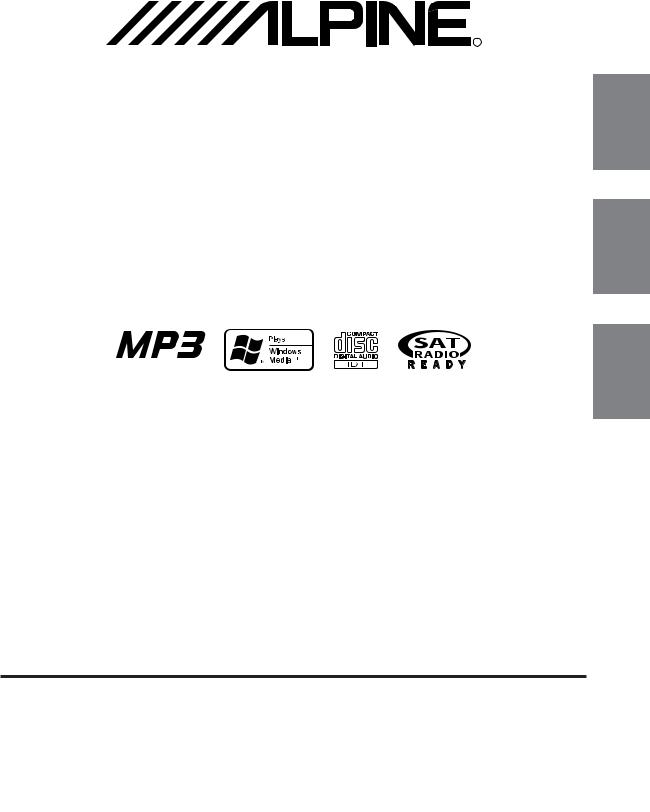
R |
EN
MP3/WMA CD Receiver
CDA-9851
FR
ES
• OWNER'S MANUAL
Please read before using this equipment.
• MODE D'EMPLOI
Veuillez lire avant d'utiliser cet appareil.
ES
• MANUAL DE OPERACIÓN
Léalo antes de utilizar este equipo.
IT
ALPINE ELECTRONICS MARKETING, INC. |
ALPINE ELECTRONICS OF AUSTRALIA PTY. LTD. |
ALPINE ELECTRONICS FRANCE S.A.R.L. |
|
|
1-1-8 Nishi Gotanda, |
6-8 Fiveways Boulevarde Keysborough, |
(RCS PONTOISE B 338 101 280) |
|
|
Shinagawa-ku, |
Victoria 3173, Australia |
98, Rue de la Belle Etoile, Z.I. Paris Nord Il, |
|
|
Tokyo 141-0031, Japan |
Phone 03-9769-0000 |
B.P. 50016, 95945 Roissy Charles de Gaulle |
|
|
Phone 03-5496-8231 |
ALPINE ELECTRONICS GmbH |
Cedex, France |
|
|
ALPINE ELECTRONICS OF AMERICA, INC. |
Phone 01-48638989 |
SE |
||
Frankfurter Ring 117, 80807 München, Germany |
||||
|
||||
19145 Gramercy Place, Torrance, |
Phone 089-32 42 640 |
ALPINE ITALIA S.p.A. |
||
California 90501, U.S.A. |
ALPINE ELECTRONICS OF U.K. LTD. |
Viale C. Colombo 8, 20090 Trezzano |
|
|
Phone 1-800-ALPINE-1 (1-800-257-4631) |
Sul Naviglio (MI), Italy |
|
||
Alpine House |
|
|||
ALPINE ELECTRONICS OF CANADA, INC. |
Phone 02-484781 |
|
||
Fletchamstead Highway, Coventry CV4 9TW, U.K. |
|
|||
|
|
|||
7300 Warden Ave., Suite 203, Markham, |
Phone 0870-33 33 763 |
ALPINE ELECTRONICS DE ESPAÑA, S.A. |
|
|
Ontario L3R 9Z6, Canada |
|
Portal de Gamarra 36, Pabellón, 32 |
|
|
Phone 1-800-ALPINE-1 (1-800-257-4631) |
|
01013 Vitoria (Alava)-APDO 133, Spain |
|
|
|
|
Phone 945-283588 |
|
Dalian Ikemiya Printing Co., LTD. |
Designed by ALPINE Japan |
4 Jin Zhou Street Economic & Technical Development |
Printed in China (Y) |
Dalian, China |
68-02278Z07-A |
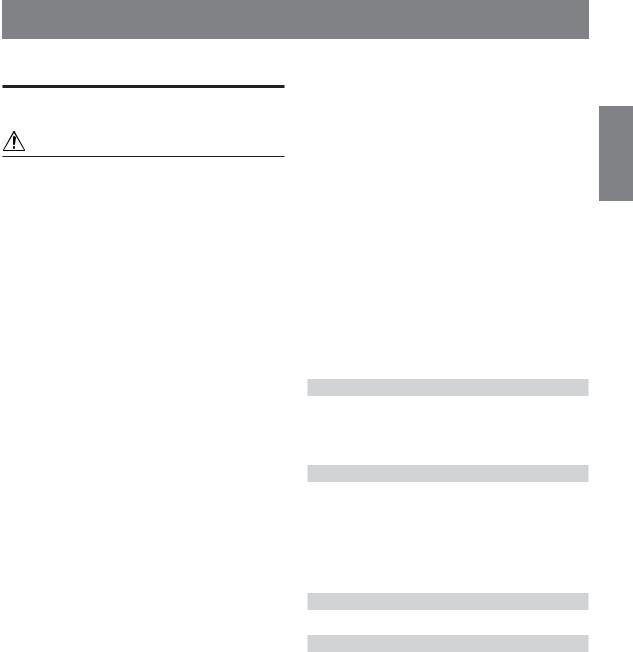
Contents |
|
Operating Instructions |
|
WARNING |
|
WARNING .................................................. |
3 |
CAUTION ................................................... |
3 |
PRECAUTIONS ......................................... |
3 |
Getting Started |
|
Turning Power On and Off ............................... |
6 |
Initial System Start-Up ..................................... |
6 |
Setting Time ...................................................... |
6 |
Opening and Closing the Movable Display ...... |
6 |
Display Tilt Adjustment .................................... |
6 |
Adjusting Volume ............................................. |
7 |
Lowering Volume Quickly ................................ |
7 |
Detaching and Attaching the Front Panel ......... |
7 |
Radio |
|
Changing the Radio Frequencies for each |
|
Country .......................................................... |
7 |
Listening to Radio ............................................. |
7 |
Manual Storing of Station Presets .................... |
8 |
Automatic Memory of Station Presets .............. |
8 |
Tuning to Preset Stations .................................. |
8 |
Station Title Search Function ............................ |
8 |
Frequency Search Function............................... |
8 |
CD/MP3/WMA |
|
Playback ............................................................ |
9 |
Repeat Play ..................................................... |
10 |
M.I.X. (Random Play) .................................... |
10 |
Scanning Programs ......................................... |
11 |
Searching from CD Text ................................. |
11 |
File/Folder Name Search |
|
(concerning MP3/WMA) ............................ |
11 |
Quick Search ................................................... |
11 |
About MP3/WMA .......................................... |
12 |
ENGLISH
Sound Setting |
|
Adjusting Bass/Treble/Balance (Between Left |
|
and Right)/Fader (Between Front and Rear)/ |
|
Defeat .......................................................... |
13 |
Setting the BBE Mode .................................... |
13 |
Setting the Bass Control ................................. |
14 |
Setting the Treble Control ............................... |
14 |
Other Functions |
|
Displaying the Title/Text ................................. |
15 |
Titling Discs/Stations ...................................... |
16 |
Erasing Disc Title/Station Title ....................... |
16 |
Displaying Time .............................................. |
16 |
SETUP |
|
Sound Customizing |
|
Subwoofer On and Off .................................... |
17 |
Setting the Subwoofer System ........................ |
17 |
Sound (Beep) Guide Function ........................ |
17 |
Visual Customizing |
|
Dimmer Control .............................................. |
17 |
Scroll Setting................................................... |
17 |
Scroll Type Setting .......................................... |
17 |
Adjusting Display Contrast ............................. |
17 |
Demonstration ................................................. |
17 |
MP3/WMA |
|
Playing MP3/WMA Data ................................ |
18 |
External Device |
|
Turning Mute Mode On/Off............................ |
18 |
Setting the AUX Mode (V-Link) ..................... |
18 |
Connecting to an External Amplifier .............. |
18 |
Setting the External Digital Input ................... |
18 |
Connecting an Optical Digital Compatible |
|
Audio Processor and an Ai-NET |
|
Non-Compatible DVD Player ..................... |
18 |
1-EN

SAT Radio Receiver (Optional) |
|
Receiving Channels with the |
|
SAT Radio Receiver (Optional) ................... |
19 |
Checking the SAT Radio ID Number .................. |
19 |
Storing Channel Presets .................................. |
20 |
Receiving Stored Channels ............................. |
20 |
Channel/Category Search Function ................ |
20 |
Quick Search Function.................................... |
20 |
Changing the Display ...................................... |
20 |
Setting the Auxiliary Data Field Display ........ |
21 |
iPod™ Operation (Optional) |
|
Playback .......................................................... |
22 |
Searching for a desired Song .......................... |
22 |
Searching by Playlist ................................... |
22 |
Searching by artist name ............................. |
22 |
Searching by album name ........................... |
23 |
Quick Search ................................................... |
23 |
Random Play Shuffle (M.I.X.) ....................... |
23 |
Repeat Play ..................................................... |
23 |
Displaying the Text ......................................... |
23 |
Changer (Optional) |
|
Controlling CD Changer (Optional) ............... |
24 |
Playing MP3 Files with the CD Changer |
|
(Optional) .................................................... |
24 |
Multi-Changer Selection (Optional) ............... |
24 |
Remote Control |
|
Controls on Remote Control ........................... |
25 |
Battery Replacement ....................................... |
26 |
Information |
|
In Case of Difficulty ....................................... |
26 |
Specifications .................................................. |
29 |
Installation and Connections
Warning ........................................................... |
30 |
Caution ............................................................ |
30 |
Precautions ...................................................... |
30 |
Installation ...................................................... |
31 |
Connections .................................................... |
32 |
LIMITED WARRANTY
2-EN
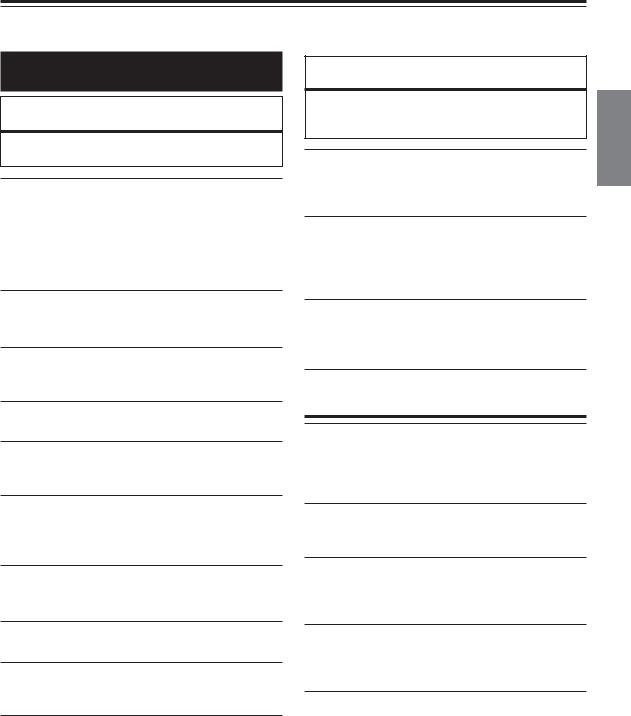
Operating Instructions
WARNING
 WARNING
WARNING
This symbol means important instructions. Failure to heed them can result in serious injury or death.
DO NOT OPERATE ANY FUNCTION THAT TAKES YOUR ATTENTION AWAY FROM SAFELY DRIVING YOUR VEHICLE.
Any function that requires your prolonged attention should only be performed after coming to a complete stop. Always stop the vehicle in a safe location before performing these functions. Failure to do so may result in an accident.
KEEP THE VOLUME AT A LEVEL WHERE YOU CAN STILL HEAR OUTSIDE NOISE WHILE DRIVING.
Failure to do so may result in an accident.
MINIMIZE DISPLAY VIEWING WHILE DRIVING.
Viewing the display may distract the driver from looking ahead of the vehicle and cause an accident.
DO NOT DISASSEMBLE OR ALTER.
Doing so may result in an accident, fire or electric shock.
USE ONLY IN CARS WITH A 12 VOLT NEGATIVE GROUND.
(Check with your dealer if you are not sure.) Failure to do so may result in fire, etc.
KEEP SMALL OBJECTS SUCH AS BATTERIES OUT OF THE REACH OF CHILDREN.
Swallowing them may result in serious injury. If swallowed, consult a physician immediately.
USE THE CORRECT AMPERE RATING WHEN REPLACING FUSES.
Failure to do so may result in fire or electric shock.
DO NOT BLOCK VENTS OR RADIATOR PANELS.
Doing so may cause heat to build up inside and may result in fire.
USE THIS PRODUCT FOR MOBILE 12V APPLICATIONS.
Use for other than its designed application may result in fire, electric shock or other injury.
DO NOT PLACE HANDS, FINGERS OR FOREIGN OBJECTS IN INSERTION SLOTS OR GAPS.
Doing so may result in personal injury or damage to the product.
 CAUTION
CAUTION
This symbol means important instructions. Failure to heed them can result in injury or material property damage.
HALT USE IMMEDIATELY IF A PROBLEM APPEARS.
Failure to do so may cause personal injury or damage to the product. Return it to your authorized Alpine dealer or the nearest Alpine Service Center for repairing.
DO NOT MIX NEW BATTERIES WITH OLD BATTERIES. INSERT WITH THE CORRECT BATTERY POLARITY.
When inserting the batteries, be sure to observe proper polarity (+ and –) as instructed. Rupture or chemical leakage from the battery may cause fire or personal injury.
KEEP FINGERS AWAY WHILE THE MOTORIZED FRONT PANEL OR MOVING MONITOR IS IN MOTION.
Failure to do so may result in personal injury or damage to the product.
 PRECAUTIONS
PRECAUTIONS
Product Cleaning
Use a soft dry cloth for periodic cleaning of the product. For more severe stains, please dampen the cloth with water only. Anything else has the chance of dissolving the paint or damaging the plastic.
Temperature
Be sure the temperature inside the vehicle is between +60°C (+140°F) and –10°C (+14°F) before turning your unit on.
Moisture Condensation
You may notice the CD playback sound wavering due to condensation. If this happens, remove the disc from the player and wait about an hour for the moisture to evaporate.
Damaged Disc
Do not attempt to play cracked, warped, or damaged discs. Playing a bad disc could severely damage the playback mechanism.
Maintenance
If you have problems, do not attempt to repair the unit yourself. Return it to your Alpine dealer or the nearest Alpine Service Station for servicing.
3-EN
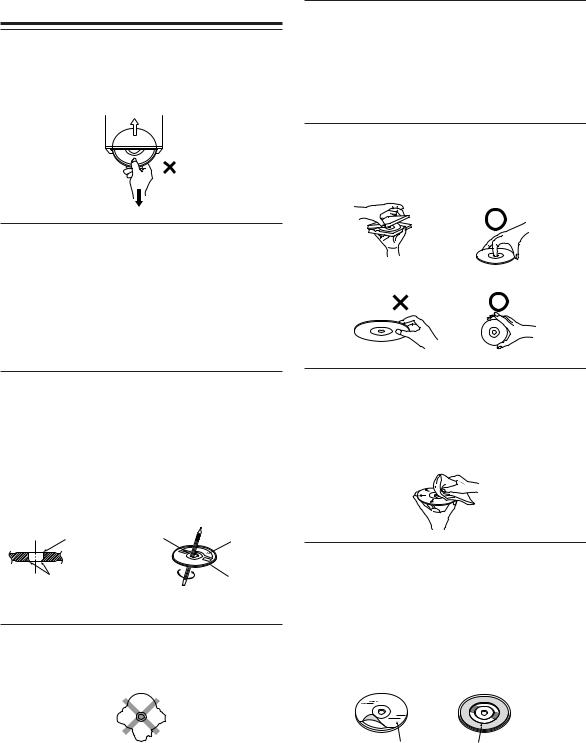
 PRECAUTIONS
PRECAUTIONS
Never Attempt the Following
Do not grip or pull out the disc while it is being pulled back into the player by the automatic reloading mechanism.
Do not attempt to insert a disc into the unit when the unit power is off.
Inserting Discs
Your player accepts only one disc at a time for playback. Do not attempt to load more than one disc.
Make sure the label side is facing up when you insert the disc. Your player will automatically eject any disc that is inserted incorrectly. If the player continues to eject a correctly inserted disc, push the RESET switch with a pointed object such as a ballpoint pen.
Playing a disc while driving on a very bumpy road may result in skips, but this will not scratch the disc or damage the player.
New Discs
As a protective measure to prevent the CD from jamming, the CD player will automatically eject discs with irregular surfaces or inserted incorrectly. When a new disc is inserted into the player and ejected after initial loading, using your finger, feel around the inside of the center hole and outside edge of the disc. If you feel any small bumps or irregularities, this could inhibit proper loading of the disc. To remove the bumps, rub the inside edge of the hole and outside edge of the disc with a ballpoint pen or other such instrument, then insert the disc again.
Center Hole |
Center Hole |
New |
|
|
Disc |
Bumps |
|
Outside |
|
|
(Bumps) |
Irregular Shaped Discs
Be sure to use round shape discs only for this unit and never use any special shape discs.
Use of special shape discs may cause damage to the mechanism.
Installation Location
Make sure the CDA-9851 will not be installed in a location subjected to:
•Direct sun and heat
•High humidity and water
•Excessive dust
•Excessive vibrations
Correct Handling
Do not drop the disc while handling. Hold the disc so you will not leave fingerprints on the surface. Do not affix tape, paper, or gummed labels to the disc. Do not write on the disc.
CORRECT
INCORRECT CORRECT
Disc Cleaning
Fingerprints, dust, or soil on the surface of the disc could cause the CD player to skip. For routine cleaning, wipe the playing surface with a clean, soft cloth from the center of the disc to the outer edge. If the surface is heavily soiled, dampen a clean, soft cloth in a solution of mild neutral detergent before cleaning the disc.
Disc Accessories
There are various accessories available on the market for protecting the disc surface and improving sound quality. However, most of them will influence the thickness and/or diameter of the disc. Using such accessories can cause the disc to be out of standard specifications and may create operational problems. We recommend not using these accessories on discs played in Alpine CD players.
Transparent Sheet Disc Stabilizer
4-EN
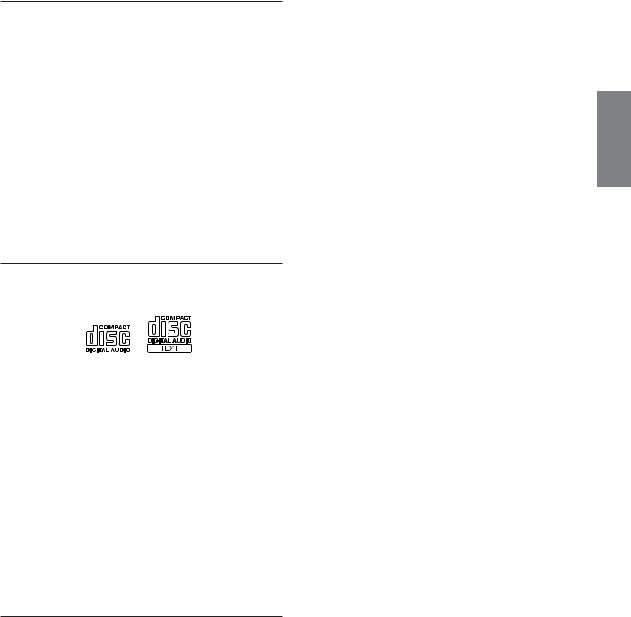
On handling Compact Discs (CD/CD-R/CD-RW)
•Do not touch the surface.
•Do not expose the disc to direct sunlight.
•Do not affix stickers or labels.
•Clean the disc when it is dusty.
•Make sure that there are no bumps around the disc.
•Do not use commercially available disc accessories.
Do not leave the disc in the car or the unit for a long time. Never expose the disc to direct sunlight. Heat and humidity may damage the CD and you may not be able to play it again.
To customers using CD-R/CD-RW
•If a CD-R/CD-RW cannot be played back, make sure the last recording session was closed (finalized).
•Finalize the CD-R/CD-RW if necessary, and attempt playback again.
About media that can be played.
Use only compact discs with the label side showing the CD logo marks below.
If you use unspecified compact discs, correct performance cannot be guaranteed.
You can play CD-Rs (CD-Recordable)/CD-RWs (CDReWritable) which have been recorded only on audio devices. You can also play CD-Rs/CD-RWs containing MP3/WMA formatted audio files.
•Some of the following CDs may not play on this unit: Flawed CDs, CDs with fingerprints, CDs exposed to extreme temperatures or sunlight (e.g., left in the car or this unit), CDs recorded under unstable conditions, CDs on which a recording failed or a re-recording was attempted, copyprotected CDs which do not conform to the audio CD industry standard.
•Use discs with MP3/WMA files written in a format compatible with this unit. For details, see page 12-13.
•ROM data other than audio files contained in a disc will not produce sound when played back.
Windows Media and the Windows logo are trademarks, or registered trademarks of Microsoft Corporation in the United States and /or other countries.
Apple, the Apple logo and iPod are trademarks of Apple Computer, Inc., registered in the U.S. and other countries.
5-EN
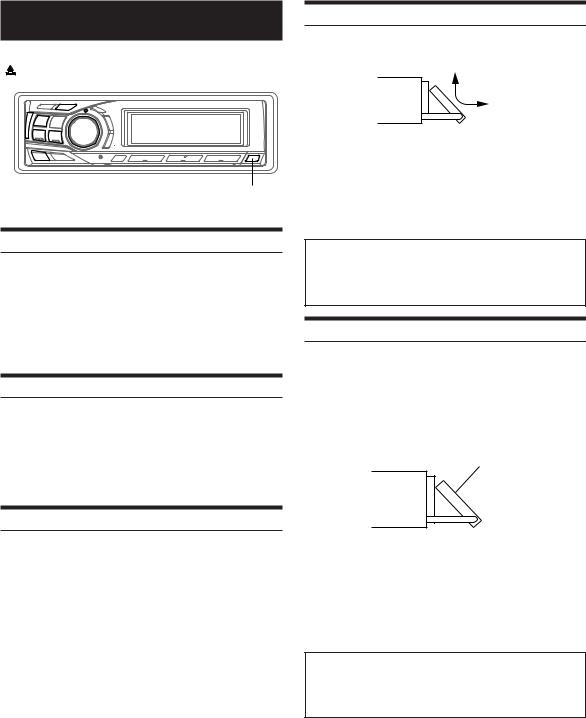
Getting Started
|
|
|
|
SOURCE/ |
|
|
|
|
Rotary |
||||||||
|
|
|
|
POWER |
MUTE RESET |
encoder |
|||||||||||
|
|
|
|
|
|
|
|
|
|
|
|
|
|
|
|
|
|
|
|
|
|
|
|
|
|
|
|
|
|
|
|
|
|
|
|
|
|
|
|
|
|
|
|
|
|
|
|
|
|
|
|
|
|
|
|
|
|
|
|
|
|
|
|
|
|
|
|
|
|
|
|
|
|
|
|
|
|
|
|
|
|
|
|
|
|
|
|
|
|
|
|
|
|
|
|
|
|
|
|
|
|
|
|
|
|
|
|
|
|
|
|
|
|
|
|
|
|
|
|
|
|
|
|
|
|
|
|
|
|
|
|
|
|
|
|
|
|
|
|
|
|
|
|
|
|
|
|
|
|
|
|
|
|
|
|
|
|
|
|
|
|
|
|
|
|
|
|
|
|
|
|
|
|
|
|
|
|
|
|
g MENU f |
c |
Turning Power On and Off
Press SOURCE/POWER to turn on the unit.
•The unit can be turned on by pressing any other button except eject c, TITLE.
Press and hold SOURCE/POWER for at least 2 seconds to turn off the unit.
• The first time power is turned on, the volume will start from level 12.
Initial System Start-Up
Be sure to press the RESET switch when using the unit for the first time, after installing the CD changer, after changing the car battery, etc.
1 Turn off the unit power.
2 Press RESET with a ball-point pen or similar pointed object.
Setting Time
1 Press MENU to select SETUP.
2 Press gor fto select the CLOCK mode.
3
4
5 Turn the Rotary encoder to adjust the minutes.
6 When the minute has been adjusted, press the
Rotary encoder.
7 When the setting has been completed, press MENU to select RETURN.
The unit returns to normal mode.
Pressing and holding MENU for at least 2 seconds will return to normal mode.
•To synchronize the clock to another clock/watch or radio time announcement, press and hold the Rotary encoder for at least 2 seconds after setting the “hour.” Minutes will reset to 00. If the display shows over “30” minutes when you do this, the time will advance one hour.
•If no operation is performed in 60 seconds, the unit returns to normal mode.
Opening and Closing the Movable Display
Press c.
The movable display will open.
To close the movable display, press c again.
The movable display will close.
•Do not apply shock to the movable display when it is open as it may result in malfunction of the unit.
•The display may be dim during low temperatures and immediately after turning on the power. The brightness will return to normal as time elapses.
•The display will stop at the set tilt angle when closing.
Caution
Keep hands (or any other object) away from the display while it is opening or closing to avoid damage or injury. The back of the movable display will get very warm under normal operating conditions. This is not a malfunction. Do not touch.
Display Tilt Adjustment
The movable display may be adjusted to 3 different tilt angles depending upon user preference.
1 Press MENU to select the TILT mode.
2 Turn the Rotary encoder to adjust the tilt angle of the movable display.
Movable display
3 Press MENU to select RETURN.
The display returns to normal mode.
Pressing and holding MENU for at least 2 seconds will return to normal mode.
•The display will close a half minute after the ignition key is turned to the OFF position.
•The adjusted tilt angle of the display is stored in memory. There is no need to re-adjust the tilt angle when the power is turned back on.
Caution
Keep hands (or any other object) away from the display while it is opening or closing to avoid damage or injury. The back of the movable display will get very warm under normal operating conditions. This is not a malfunction. Do not touch.
6-EN
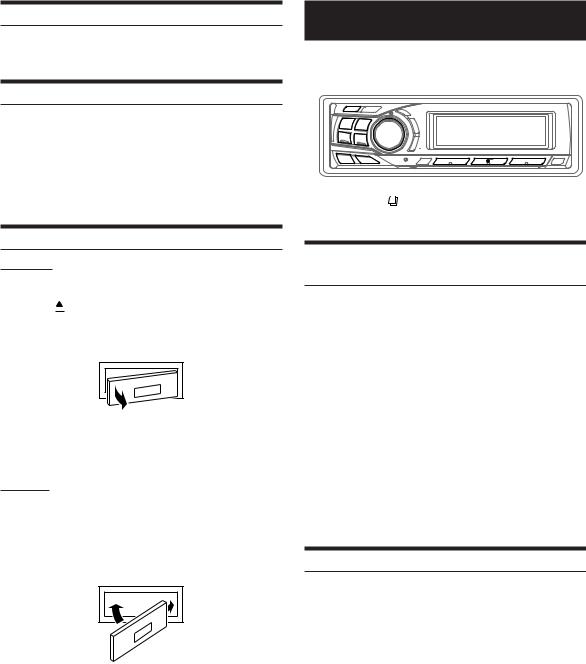
Adjusting Volume
Turn the Rotary encoder until the desired sound is obtained.
Lowering Volume Quickly
Activating the Audio Mute function will instantly lower the volume level by 20 dB.
Press MUTE to activate the MUTE mode.
The audio level will decrease by about 20 dB.
Pressing MUTE again will bring the audio back to its previous level.
Radio
SOURCE/ |
|
TUNE/ |
|
|
|
|
|
|
|
|||||||
POWER |
|
A.ME |
|
BAND |
Rotary encoder |
|
||||||||||
|
|
|
|
|
|
|
|
|
|
|
|
|
|
|
|
|
|
|
|
|
|
|
|
|
|
|
|
|
|
|
|
|
|
|
|
|
|
|
|
|
|
|
|
|
|
|
|
|
|
|
|
|
|
|
|
|
|
|
|
|
|
|
|
|
|
|
|
|
|
|
|
|
|
|
|
|
|
|
|
|
|
|
|
|
|
|
|
|
|
|
|
|
|
|
|
|
|
|
|
|
|
|
|
|
|
|
|
|
|
|
|
|
|
|
|
|
|
|
|
|
|
|
|
|
|
|
|
|
|
|
|
|
|
|
|
|
|
|
|
|
|
|
|
|
|
|
|
|
|
|
|
|
|
|
|
|
|
|
|
|
|
|
|
|
|
|
|
|
|
gMENU f |
Preset buttons |
|
(1 through 6) |
Detaching and Attaching the Front Panel
Detaching
1 Turn off the unit power.
2 Press  (Release) at the upper left side until the front panel pops out.
(Release) at the upper left side until the front panel pops out.
3 Grasp the left side of the front panel and pull it out.
•The front panel may become hot in normal usage (especially the connector terminals on the back of the front panel.) This is not a malfunction.
•To protect the front panel, place it in the supplied carrying case.
Attaching
1 Insert the right side of the front panel into the main unit. Align the groove on the front panel with the projections on the main unit.
2 Push the left side of the front panel until it locks firmly into the main unit.
2 |
1 |
•Before attaching the front panel, make sure that there is no dirt or dust on the connector terminals and no foreign object between the front panel and the main unit.
•Attach the front panel carefully. Hold the panel by its sides to avoid pushing any buttons by mistake.
Changing the Radio Frequencies for each Country
For customers not living in North America, change the radio frequencies as follows.
1 Press MENU to select the SETUP mode.
2 Select the “AREA” mode by pressing gor f.
3 Choose either AREA 1 or AREA 2 by turning the
Rotary encoder.
AREA 1: Radio frequencies for North America AREA 2: Other Radio frequencies
4 Press MENU to select RETURN.
The unit returns to normal mode.
Pressing and holding MENU for at least 2 seconds will return to normal mode.
•The stored radio stations will be cleared every time you change the setting.
Listening to Radio
1 Press SOURCE/POWER until a radio frequency appears in the display.
2 Press BAND repeatedly until the desired radio band is displayed.
FM1 → FM2 → AM → FM1
3 Press TUNE/A.ME to select the tuning mode.
DX SEEK (Distance mode) → SEEK (Local mode) → OFF (Manual mode) → DX SEEK
• The initial mode is DX SEEK (Distance mode).
Distance mode:
Both strong and weak stations will be automatically tuned in (Automatic Seek Tuning).
Local mode:
Only strong stations will be automatically tuned in (Automatic Seek Tuning).
Manual mode:
The frequency is manually tuned in steps (Manual tuning).
Continued
7-EN
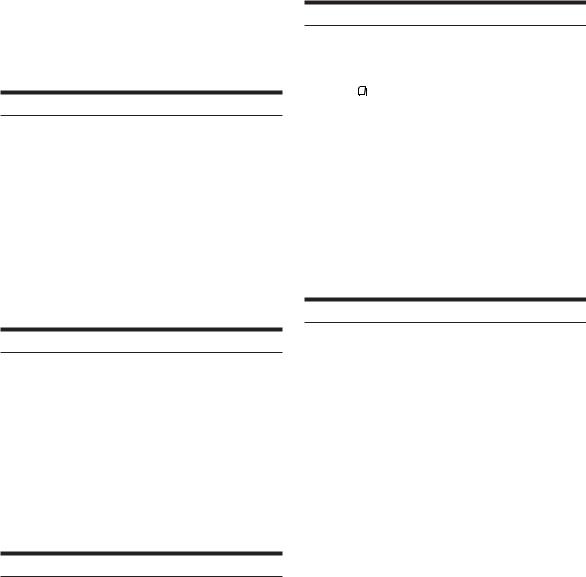
4 Press gor fto tune in the desired station.
Holding down gor fwill change the frequency continuously.
•The ST indicator appears on the display when a stereo FM station is tuned in.
Manual Storing of Station Presets
1 Select the radio band and tune in a desired radio station you wish to store in the preset memory.
2 Press and hold, for at least 2 seconds, any one of the preset buttons (1 through 6) into which you wish to store the station.
The selected station is stored.
The display shows the band, preset no. and station frequency memorized.
•A total of 18 stations can be stored in the preset memory (6 stations for each band; FM1, FM2 and AM).
•If you store a station in a preset memory which already has a station, the current station will be cleared and replaced with the new station.
Automatic Memory of Station Presets
1 Press BAND repeatedly until the desired radio band is displayed.
2 Press and hold TUNE/A.ME for at least 2 seconds.
The frequency on the display continues to change while the automatic memory is in progress. The tuner will automatically seek and store 6 strong stations in the selected band. They will be stored into buttons 1 to 6 in order of signal strength.
When the automatic memory has been completed, the tuner goes to the station stored in preset location no. 1.
•If no stations are stored, the tuner will return to the original station you were listening to before the auto memory procedure began.
Tuning to Preset Stations
1 Press BAND repeatedly until the desired band is displayed.
2 Press any one of the station preset buttons (1 through 6) that has your desired radio station in memory.
The display shows the band, preset number and frequency of the station selected.
•Search mode in Title Search mode is canceled by pressing and holding for at least 2 seconds.
for at least 2 seconds.
•If a station has no title, “NO TITLE” is displayed for 2 seconds.
•Any radio station can be searched by the Station Title Search function. The station titles are displayed in the order they were input.
Frequency Search Function
You can search for a radio station by its frequency.
1 Press and hold for at least 2 seconds in Radio mode to activate Frequency Search mode.
for at least 2 seconds in Radio mode to activate Frequency Search mode.
2 Turn the Rotary encoder within 10 seconds to select the desired frequency.
3 Press the Rotary encoder to receive the selected frequency.
•Search mode in Frequency Search mode is canceled by pressing and holding for at least 2 seconds.
for at least 2 seconds.
8-EN
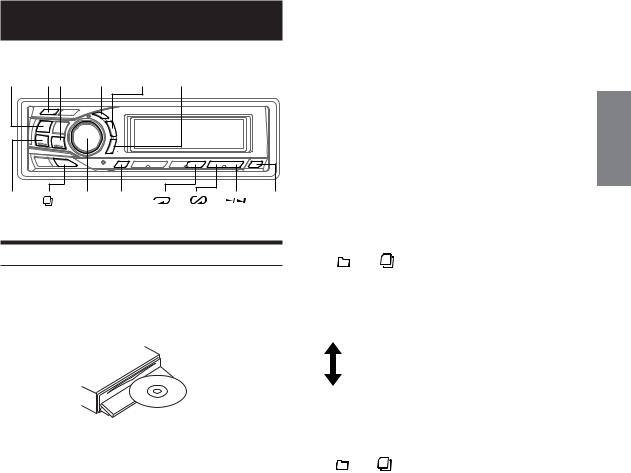
CD / MP3 / WMA
SOURCE/ |
|
|
POWER -/J f TITLE |
8 |
9 |
g |
Rotary F |
4( |
) 5( |
) 6( |
) |
c |
|
encoder |
|
|
|
|
|
Playback
1 Press c.
The movable display will open.
2 Insert a disc with the label side facing up.
The disc will be pulled into the unit automatically.
The movable display will close and playback will begin. When a disc is already inserted, press SOURCE/POWER to switch to the CD mode.
The mode will change every time the button is pressed.
TUNER → CD → CD CHANGER* → TUNER
* Only when the CD changer is connected
3 While playing back MP3/WMA, press 8 or 9 to select the desired folder.
Pressing and holding 8 or 9 will change folders continuously.
4 Press gor fto select the desired track (file).
Returning to the beginning of the current track (file):
Press g.
Fast backward :
Press and hold g.
Advancing to the beginning of the next track (file) :
Press f.
Fast forward :
Press and hold f.
5 To pause playback, press -/J.
Pressing -/J again will resume playback.
6 To eject the disc, press c.
•Do not remove a CD during its eject cycle. Do not load more than one disc at a time. A malfunction may result from doing either.
•If the CD does not eject, press and hold c for at least 2 seconds with the movable display open.
•The CD-player can play discs containing audio data, MP3 data and WMA data.
•A WMA format file that is protected by DRM (Digital Rights Management) cannot be played back on this unit.
•“MP3” is displayed during MP3 playback.
•“WMA” is displayed during WMA playback.
•The track display for MP3/WMA data playback is the file numbers recorded on the disc.
•If the HDA-5460 model is connected to the unit, some operations (for example changing the source, selecting the file by holding buttons up or down, etc.), can be carried out on this unit.
MP3/WMA Play Display
The folder number, file number, sampling rate, and bit rate will be displayed as described below.
File number display
|
|
|
|
|
|
|
|
|
|
|
|
|
|
|
|
|
|
|
|
|
|
|
|
|
|
|
|
|
|
|
|
|
|
|
|
|
|
01 |
|
|
|
03 44.1kHz |
|||||
|
|
||||||||||
|
|
|
|
|
|
|
|
|
|
|
|
|
|
|
|
|
|
|
|
|
|
|
|
|
|
|
|
|
|
|
|
|
|
||
Folder number |
|
Sampling rate |
|||||||||
display |
|
display |
|||||||||
The sampling rate and the bit rate (frame display*) are alternately displayed.
File number display
|
|
|
|
|
|
|
|
|
|
|
|
|
|
|
|
|
|
|
|
|
|
|
|
|
|
|
|
|
|
|
|
|
01 |
|
03 |
|
|
|
|||||
|
|
|
|
|
|
|
160 kbps |
|||
|
|
|
|
|
||||||
|
|
|
|
|
|
|
|
|
|
|
|
|
|
|
|
|
|
|
|
|
|
|
|
|
|
|
|
|
|
|
||
Folder number |
|
|
Bit rate |
|||||||
display |
|
|
display |
|||||||
•Press TITLE to switch the display. Please see “Displaying the Title/Text” (page 15) for information about display switching.
*The recording sampling rate and bit rate of the MP3/WMA file are displayed. A WMA file of variable bit rate displays the average bit rate.
9-EN
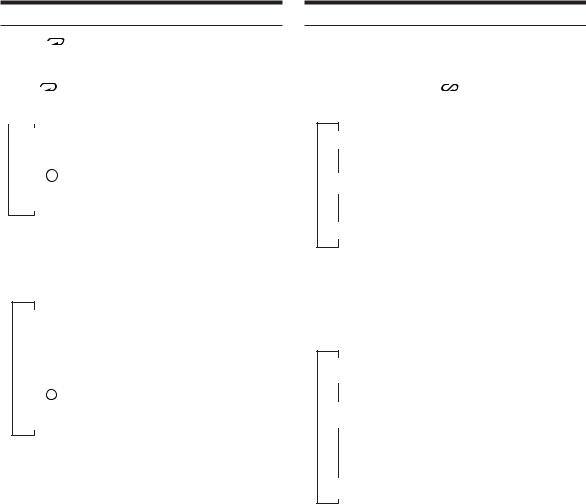
Repeat Play
Press 4 ( |
) to play back repeatedly the track being |
played.
The track (file) will be played repeatedly.
Press 4 ( |
) again and select OFF to deactivate repeat play. |
||
CD mode : |
|
||
|
|
|
|
|
↓ |
|
|
|
RPT |
: Only a track is repeatedly played back |
|
↓*1
RPT  : A disc is repeatedly played back
: A disc is repeatedly played back
↓
(off)
*1 When a CD changer is connected
•If REPEAT is set to ON during M.I.X. play in CD changer mode, M.I.X. will apply to the current disc only.
MP3/WMA mode :
↓
RPT : Only a file is repeatedly played back
↓
RPT  : Only files in a folder or playlist are repeatedly played back
: Only files in a folder or playlist are repeatedly played back
↓*2
RPT  : A disc is repeatedly played back
: A disc is repeatedly played back
↓
(off)
*2 When an MP3 compatible CD changer is connected
•If a 6-disc CD changer or an MP3 compatible CD changer is connected:
In CD changer mode, press F to illuminate the “FUNC” indicator, and go to the step above within 10 seconds.
•If a 12-disc CD changer is connected:
In CD changer mode, press F twice to illuminate the “FUNC” indicator, and go to the step above within 10 seconds.
M.I.X. (Random Play)
Press 5 ( ) in the play or pause mode.
) in the play or pause mode.
The tracks (files) on the disc will be played back in random sequence.
To cancel M.I.X. play, press 5 ( |
) again. |
CD mode :
↓
M.I.X.: Track are played back in random sequence.
↓*3
 M.I.X.: The tracks on all the CDs in the current magazine will be included in the random playback sequence.
M.I.X.: The tracks on all the CDs in the current magazine will be included in the random playback sequence.
*3 When a CD changer equipped with the All M.I.X. function is connected
•If M.I.X. is set to ON during RPT (REPEAT ALL) play in CD changer mode, M.I.X. will apply to the current disc only.
(REPEAT ALL) play in CD changer mode, M.I.X. will apply to the current disc only.
MP3/WMA mode :
↓
 M.I.X.: Only files in a folder are played back in
M.I.X.: Only files in a folder are played back in
random sequence.
↓
 M.I.X.: Files are played back in random sequence. If an MP3 compatible CD changer is connected, all files in a disc are played back in random sequence, and playback shifts to the next disc.
M.I.X.: Files are played back in random sequence. If an MP3 compatible CD changer is connected, all files in a disc are played back in random sequence, and playback shifts to the next disc.
•If a 6-disc CD changer or an MP3 compatible CD changer is connected:
In CD changer mode, press F to illuminate the “FUNC” indicator, and go to the step above within 10 seconds.
•If a 12-disc CD changer is connected:
In CD changer mode, press F twice to illuminate the “FUNC” indicator, and go to the step above within 10 seconds.
10-EN

Scanning Programs
Press 6 (
 ) to activate the Scan mode.
) to activate the Scan mode.
The first 10 seconds of each track (file) will be played back in succession.
To stop scanning, press 6 (  ) and deactivate the Scan mode.
) and deactivate the Scan mode.
•If a 6-disc CD changer or an MP3 compatible CD changer is connected:
In CD changer mode, press F to illuminate the “FUNC” indicator, and go to the step above within 10 seconds.
•If a 12-disc CD changer is connected:
In CD changer mode, press F twice to illuminate the “FUNC” indicator, and go to the step above within 10 seconds.
Searching from CD Text
Tracks can be searched and played using the CD text on the disk. In the case of discs and changers that do not support text, searches can be made using the track numbers.
1 Press during play.
during play.
This will set the search mode.
2 Turn the Rotary encoder to select the desired track, then press the Rotary encoder.
This will play the selected track.
•Press and hold for at least 2 seconds in the search mode to cancel. Or, the search mode will be canceled when an operation has not been performed in 10 seconds.
for at least 2 seconds in the search mode to cancel. Or, the search mode will be canceled when an operation has not been performed in 10 seconds.
•CD text search cannot be made during M.I.X. play.
File/Folder Name Search
(concerning MP3/WMA)
You can display and search for the folder and file name while listening to the file currently being played back.
1 Press to select Folder Name Search mode or File Name Search mode in MP3/WMA mode.
to select Folder Name Search mode or File Name Search mode in MP3/WMA mode.
Folder Name Search mode
2 Turn the Rotary encoder within 10 seconds to select the desired folder.
3 Press the Rotary encoder to play back the first file in the selected folder.
• |
Search mode is canceled by pressing and holding for at least 2 |
|
seconds in Folder Name Search mode. |
• |
While in Folder Name Search mode, press to switch to File |
|
Name Search mode. |
•“NO FILE” is displayed if the folder that is selected by the Folder Name Search mode contains no files.
•“ROOT” is displayed for the root folder which doesn’t have folder name.
•Folder Name Search cannot be made during M.I.X. play.
File Name Search mode
2 Press 8 or 9 to select another Folder.
3 Select the desired file by turning the Rotary encoder within 10 seconds.
4 Press the Rotary encoder to play back the selected file.
•File Name Search mode is canceled by pressing and holding for at least 2 seconds.
• While in File Name Search mode, press to switch to Folder Name Search mode.
• File Name Search cannot be made during M.I.X. play.
Quick Search
You can search for tracks(files).
1 Press and hold  for at least 2 seconds in the CD/ Changer/MP3/WMA mode to activate Quick Search mode.
for at least 2 seconds in the CD/ Changer/MP3/WMA mode to activate Quick Search mode.
2 Turn the Rotary encoder within 10 seconds to select a desired track(file).
The selected track is played back immediately.
•Search mode is canceled by pressing and holding for at least 2 seconds in Quick Search mode.
for at least 2 seconds in Quick Search mode.
11-EN
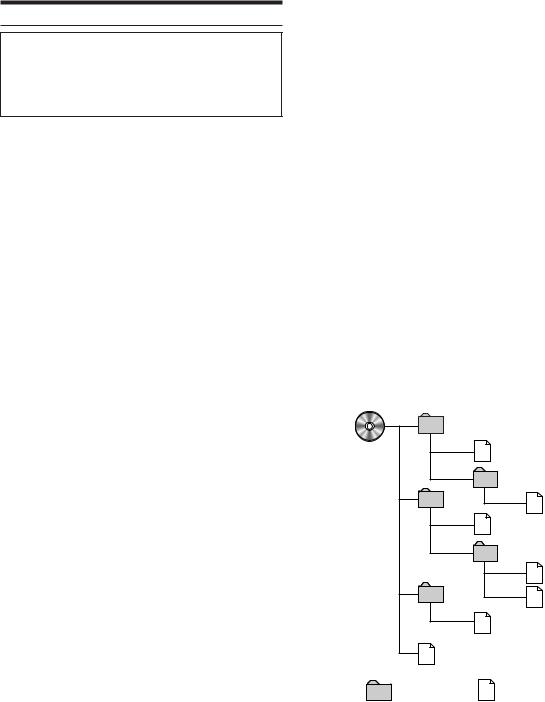
About MP3/WMA
CAUTION
Except for private use, duplicating audio data (including MP3/ WMA data) or distributing, transferring, or copying it, whether for free or for a fee, without permission of the copyright holder is strictly prohibited by the Copyright Act and by international treaty.
What is MP3?
MP3, whose official name is “MPEG-1 Audio Layer 3,” is a compression standard prescribed by the ISO, the International Standardization Organization and MPEG which is a joint activity institution of the IEC.
MP3 files contain compressed audio data. MP3 encoding is capable of compressing audio data at extremely high ratios, reducing the size of music files to as much as one-tenth their original size. This is achieved while still maintaining near CD quality. The MP3 format realizes such high compression ratios by eliminating the sounds that are either inaudible to the human ear or masked by other sounds.
What is WMA?
WMA, or “Windows Media™ Audio,” is compressed audio data.
WMA allows you to create music files and store them at higher ratios of compression than MP3 audio data (approx. half original size). This is achieved while still maintaining CD quality sound.
Method for creating MP3/WMA files
Audio data is compressed by using MP3/WMA specified software. For details on creating MP3/WMA files, refer to the user's manual for that software.
MP3/WMA files that can be played back by this device have the file extension “mp3” / “wma”. Files with no extension cannot be played back. (WMA ver. 7.1, 8 and 9 are supported)
Supported playback sampling rates and bit rates
MP3 |
|
|
|
Sampling rates |
: 48 kHz, 44.1 kHz, 32 kHz, 24 kHz, 22.05 kHz, |
||
|
16 kHz, 12 kHz, 11.025 kHz, 8 kHz |
||
Bit rates: |
8 |
- 320 kbps |
|
Variable Bit rates: 8 |
- 320 kbps |
||
WMA |
|
|
|
Sampling rates |
: 48 kHz, 44.1 kHz, 32 kHz |
||
Bit rates: |
48 |
- 192 kbps |
|
Variable Bit rates: 48 |
- 320 kbps |
||
Note that for sampling rates, this device’s frame display (Page 9) may not display correctly.
This device may not play back correctly depending on sampling rates.
ID3 tags/WMA tags
This device supports ID3 tag v1 and v2, and WMA tag.
If tag data is in an MP3/WMA file, this device can display the title (track title), artist name, and album name ID3 tag/WMA tag data.
This device can only display single-byte alphanumeric characters (up to 30 for ID3 tags and up to 15 for WMA tags) and the underscore. For non-supported characters, “NO SUPPORT” is displayed.
The tag information may not be correctly displayed, depending on the contents.
Producing MP3/WMA discs
MP3/WMA files are prepared, then written to a CD-R or CDRW using CD-R writing software. A disc can hold up to 510 files/folders (including Root Folders). However, the maximum number of folders is 255.
Media supported
The media that this device can play back are CD-ROMs, CDRs, and CD-RWs.
Corresponding File Systems
This device supports discs formatted with ISO9660 Level 1 or Level 2.
Under the ISO9660 standard, there are some restrictions to remember.
The maximum nested folder depth is 8 (including the root directory). The number of folder/file name characters is limited.
Valid characters for folder/file names are letters A-Z (all caps), numbers 0-9, and ‘_’ (underscore).
This device also can play back discs in Joliet, Romeo, etc., and other standards that conform to ISO9660. However, sometimes the file names, folder names, etc., are not displayed correctly.
Formats supported
This device supports CD-ROM XA, Mixed Mode CD, Enhanced CD (CD-Extra) and Multi-Session.
This device cannot correctly play back discs recorded with Track At Once or packet writing.
Order of tracks
The unit plays the files in the order that the writing software writes them. Therefore, the playing order may not be the same as the order you input. The playback order of the folders and files is as follows. However, the folder and file playback order differs from the folder no. and file no. indicated on the display.
1 |
2 |
|
Root folder |
2 |
|
|
|
|
|
3 |
|
|
4 |
3 |
|
4 |
|
|
5 |
|
|
|
5 |
|
6 |
6 |
|
7 |
|
|
1 |
|
Folder |
MP3/WMA File |
|
12-EN
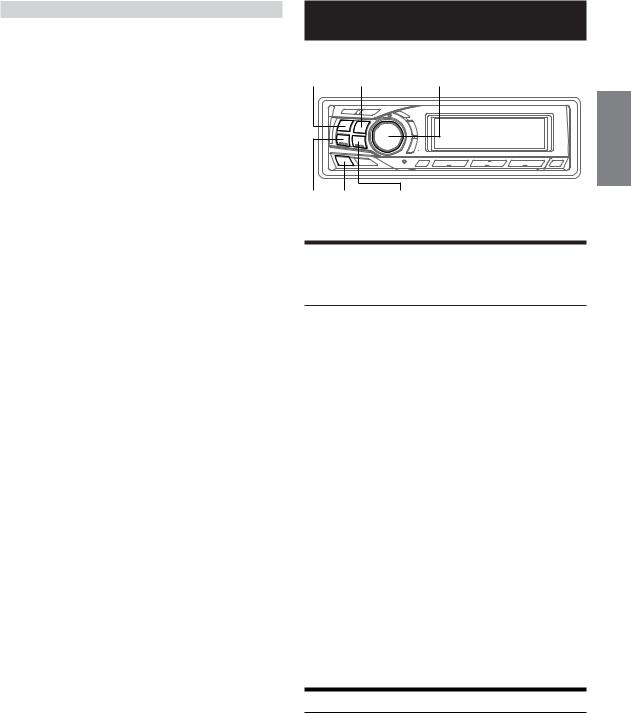
Terminology
Bit rate
This is the “sound” compression rate specified for encoding. The higher the bit rate, the higher the sound quality, but also the larger the files.
Sampling rate
This value shows how many times per second the data is sampled (recorded). For example, music CDs use a sampling rate of 44.1 kHz, so the sound is sampled (recorded) 44,100 times per second.
The higher the sampling rate, the higher the sound quality, but also the larger the volume of data.
Encoding
Converting music CDs, WAVE (AIFF) files, and other sound files into the specified audio compression format.
Tag
Song information such as track titles, artist names, album names, etc., written into MP3/WMA files.
MP3: ID3 tag WMA: WMA tag
Root folder
The root folder is found at the top of the file system. The root folder contains all folders and files.
Sound Setting
SOURCE/
POWER BAND Rotary encoder (MODE)
g MENU f
Adjusting Bass/Treble/Balance (Between Left
and Right)/Fader (Between Front and Rear)/
Defeat
1 Press Rotary encoder (MODE) repeatedly to choose the desired mode.
Each press changes the modes as follows:
BASS → TREBLE → SUBW*1 → BALANCE → FADER → DEFEAT → VOLUME → BASS
Bass : –7 ~ +10
Treble : –7 ~ +7
Subwoofer : 0 ~ +15
Balance : L15 ~ R15
Fader : R15 ~ F15
Defeat : ON/OFF
Volume : 0 ~ 35
•If the Rotary encoder (MODE) is not pressed within 5 seconds after selecting the BASS, TREBLE, BALANCE, FADER, DEFEAT or SUBWOOFER mode, the unit automatically returns to normal mode.
*1 When the subwoofer mode is set to OFF, its level cannot be adjusted.
2 Turn the Rotary encoder until the desired sound is obtained in each mode.
By setting Defeat ON, previously adjusted settings of BASS and TREBLE will return to the factory defaults and BBE is turned off.
•Depending on the connected devices, some functions and display indications do not work.
Setting the BBE Mode
BBE makes vocals or instruments sound distinct regardless of the music source. The FM radio, CD, and MP3, will be able to reproduce the music clearly even in cars with a lot of road noise.
1 Press SOURCE/POWER to select the source to which you want to apply BBE.
2 Press MENU to select BBE mode.
Continued
13-EN

3 Press gor fto set the BBE mode ON.
BBE ON  BBE OFF
BBE OFF
(BBE1 to 3, EFFECT OFF)
4 Turn the Rotary encoder to select your preferred BBE level (1 to 3) or OFF.
5 Press MENU to select RETURN.
The unit returns to normal mode.
Pressing and holding MENU for at least 2 seconds will return to normal mode.
•To cancel BBE mode for all music sources, set BBE to Off in step 3.
•Each music source, such as FM radio, CD (included MP3/WMA) can have its own BBE setting.
•This function is inoperable when DEFEAT is set to ON.
•There is no BBE mode for AM radio.
•When an external audio processor is connected, this setting cannot be made.
•If no operation is performed in 60 seconds, the unit returns to normal mode.
Setting the Bass Control
You can change the bass frequency emphasis to create your own tonal preference.
1 Press MENU to select BASS.
2-1 Setting the bass centre frequency:
Press gor fto select the desired bass centre frequency.
60Hz ↔ 80Hz ↔ 100Hz ↔ 120Hz ↔ 60Hz
The displayed bass frequency is emphasized.
2-2 Setting the bass band width (Q-Factor):
Press BAND to select the desired bass band width.
→ 1 → 2 → 3 → 4  (Narrow) ←......→ (Wide)
(Narrow) ←......→ (Wide)
Changes the boosted bass band width to wide or narrow. A wide setting will boost a wide range of frequencies above and below the centre frequency. A narrower setting will boost only frequencies near the centre frequency.
2-3*1 Setting the bass level:
Turn the Rotary encoder to select the desired bass level (–7~+10).
You can emphasize or weaken the bass level.
3 Press MENU to select RETURN.
The unit returns to normal mode.
Pressing and holding MENU for at least 2 seconds will return to normal mode.
•If no operation is performed in 60 seconds, the unit returns to normal mode.
•The bass level settings will be individually memorized for each source (FM, AM, CD, etc.) until the setting is changed. The bass frequency and bass band width settings adjusted for one source are effective for all other sources (FM, AM, CD etc.).
•Depending on the connected devices, some functions and display indications do not work. However, bass level is still adjustable if an audio processor with the bass adjustment is connected.
• This function is inoperable when DEFEAT is set to ON.
*1 The adjustment can also be made by pressing the Rotary encoder (MODE). Refer to “Adjusting Bass/Treble/Balance (Between Left and Right)/Fader (Between Front and Rear)/Defeat” (page 13).
Setting the Treble Control
You can change the Treble Frequency emphasis to create your own tonal preference.
1 Press MENU to select TREBLE.
2-1 Setting the treble Centre frequency:
Press gor fto select the desired treble centre frequency.
7.5kHz ↔ 10.0kHz ↔ 12.5kHz ↔ 15.0kHz ↔ 7.5kHz
The displayed Treble frequency is emphasized.
2-2*2 Setting the treble level:
Turn the Rotary encoder to select the desired treble level (–7~+7).
You can emphasize the treble level.
3 Press MENU to select RETURN.
The unit returns to normal mode.
Pressing and holding MENU for at least 2 seconds will return to normal mode.
•If no operation is performed in 60 seconds, the unit returns to normal mode.
•The treble level settings will be individually memorized for each source (FM, AM, CD, etc.) until the setting is changed. The Treble frequency settings adjusted for one source are effective for all other sources (FM, AM, CD, etc.).
•Depending on the connected devices, some functions and display indications do not work. However, treble level is still adjustable if an audio processor with the treble adjustment is connected.
•This function is inoperable when DEFEAT is set to ON.
*2 The adjustment can also be made by pressing the Rotary encoder (MODE). Refer to “Adjusting Bass/Treble/Balance (Between Left and Right)/Fader (Between Front and Rear)/Defeat” (page 13).
14-EN
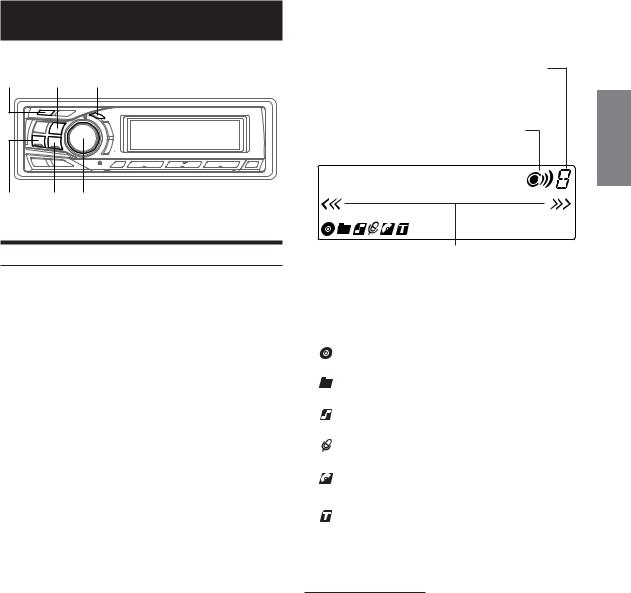
Other Functions
-/J BAND TITLE
About the indicator display
When displaying Title/Text, the following indicators are lit according to the mode.
Bass Level setting is usually displayed. When BBE is set, the BBE level setting is displayed (“H” is displayed when Bass level is set to 10, and nothing is displayed when Bass level is set below zero).
Bass Level is usually displayed. When BBE is set, the display changes according to the BBE setting.
g f Rotary encoder
Displaying the Title/Text
It is possible to display the CD/Station title if the title has been previously inputted (“Titling Discs/Stations” page 16). Text information, such as the disc name and the track name, will be displayed if playing a CD text compatible disc. It is also possible to display the folder name, the file name, and the tag, etc., while playing MP3/WMA files.
Press TITLE.
The display will change every time the button is pressed.
The display in Radio mode:
FREQUENCY → CLOCK → TITLE → FREQUENCY
The display in CD mode:
TRACK NO./ELAPSED TIME → TRACK NO./CLOCK → TEXT (DISC NAME)*1 → TEXT (TRACK NAME)*2 → TITLE → TRACK NO./ELAPSED TIME
The display in MP3/WMA mode:
FILE NO./ELAPSED TIME → FOLDER NO./FILE NO. → FILE NO./CLOCK → FOLDER NAME*3 → FILE NAME → ARTIST NAME*2 → ALBUM NAME*2 → TRACK NAME*2 →
FILE NO./ELAPSED TIME
*1 Displayed during playback of a disc with CD Text.
“NO TEXT” will be displayed when the CD contains no Text data. *2 ID3 tag/WMA tag
If an MP3/WMA file contains ID3 tag/WMA tag information, the ID3 tag/WMA tag information is displayed (e.g., track name, artist name, and album name). All other tag data is ignored.
“NO DATA” will be displayed when an MP3/WMA file contains no ID3 tag/WMA tag information.
*3 “ROOT” is displayed for the root folder which doesn’t have folder name.
Lights up if the selection is availabel after pressing gor f.
Indicator/ |
CD Mode |
MP3/WMA |
TUNER |
SAT RADIO |
||
Mode |
Mode |
Mode |
Mode |
|||
|
||||||
|
|
Title being |
— |
— |
— |
|
|
|
displayed |
||||
|
|
|
|
|
||
|
|
— |
Folder Name |
— |
— |
|
|
|
being |
||||
|
|
|
displayed |
|
|
|
|
|
|
File Name |
|
|
|
|
|
— |
being |
— |
— |
|
|
|
|
displayed |
|
|
|
|
|
|
Artist Name* |
|
Artist Name |
|
|
|
— |
being |
— |
being |
|
|
|
|
displayed |
|
displayed |
|
|
|
Text (Disc |
Album Name* |
— |
— |
|
|
|
Name) being |
being |
|||
|
|
displayed |
displayed |
|
|
|
|
|
Text (Track |
Track Name* |
Title being |
Song Title/ |
|
|
|
Name) being |
being |
displayed |
Channel |
|
|
|
displayed |
displayed |
|
Name being |
|
|
|
|
|
|
displayed |
|
|
|
|
|
|
|
|
*Tag information
About “Title” and “Text”
Title:
With this device, it is possible to input the CD/Station name (page 16). This inputted name is referred to as a “title.” You cannot input or display titles on MP3/WMA discs.
Text:
Text compatible CDs contain text information such as the disc name and track name. Such text information is referred to as “text.”
•Some characters may not be displayed correctly with this device, depending on the character type.
•The CD changer must also be CD Text compatible for the Text information to be displayed.
•When the Scroll Setting (page 17) is set to “SCR MANUAL,” press and hold TITLE for at least 2 seconds to scroll the Text information only once (TEXT DISPLAY, FOLDER NAME DISPLAY, FILE NAME DISPLAY or TAG DISPLAY mode).
•“NO SUPPORT” is displayed when the desired text information cannot be displayed on this unit.
•If the title was not previously input, “NO TITLE” is displayed.
•The text or tag information may not be correctly displayed, depending on the contents.
Continued
15-EN

Titling Discs/Stations
It is possible to title your favorite CD's or radio stations. You cannot input titles for MP3/WMA discs.
1 Press TITLE and select the Title Display.
For details, see “Displaying the Title/Text” (page 15).
2 Press and hold TITLE for at least 2 seconds. The first character will blink.
3 Press BAND to select the characters/symbols.
Upper case → Lower case → Numeral/Symbol → Upper case
4 Turn the Rotary encoder to select the desired letter/numeral/symbol available for naming.
5 Press Rotary encoder to store the first character.
The first character will stop blinking and the display will automatically advance to the next character. When that character begins to blink, you may choose the next letter or symbol of your title.
6 Repeat steps 3 and 5 above to complete the titling.
Pressing the Rotary encoder after entering the 8th character automatically stores the title into memory.
When entering a title of less than 8 characters (for example, 3 character title):
After entering 3 characters, the 4th character space will be blinking. Go to step 7 to complete the title.
7 Press TITLE to record the title.
•If you cancel while entering a title, selected characters are not written.
•You can enter 24 radio station titles and 18 CD titles on this unit. If you try to store beyond the limit, the display will show “FULL DATA.” At this point, no more titles can be stored. To input a new title, one of the previously inputted titles must first be deleted.
•The CD Changer title length or memory capacity varies depending upon the model being used.
•When you want to erase a title, enter the “ ” symbol into all spaces.
” symbol into all spaces.
•The operations described in steps 3 to 5 must be made within 10 seconds. The input mode will be canceled if no action is taken for over 10 seconds.
Erasing Disc Title/Station Title
1 Press TITLE to select the Title Display. Then, press again and hold for at least 2 seconds.
2 Press and hold -/J for at least 2 seconds.
The title in the display will blink.
3 Press gor frepeatedly until the title you want to erase is displayed.
4 Press and hold -/J for at least 2 seconds to erase the title displayed.
5 Press TITLE to cancel the title erasing mode.
•You cannot erase CD-TEXT.
•"NO DATA" is displayed for 2 seconds if the title is not input in step 2, or if all titles are erased in step 4.
Displaying Time
Press TITLE repeatedly until the time is displayed.
Each press changes the display.
For details, see “Displaying the Title/Text” (page 15).
•Selecting any tuner or CD function while in the clock priority mode will interrupt the time display momentarily. The function selected will be displayed for about 5 seconds before the time returns to the display.
•When the power is off but the ignition key is on, press TITLE to display the time.
16-EN

SETUP
You can flexibly customize the unit to suit your own preferences and usage. From the SETUP menu, choose from Sound Customizing, Visual Customizing, etc., to make your desired setting.
SOURCE/
POWER BAND Rotary encoder
g MENU f
A typical SETUP procedure is shown in steps 1 to 4 as follows. See below for further information about each SETUP menu.
1 Press MENU to select the SETUP mode.
SETUP mode is activated.
2 Press gor fto select the desired SETUP menu.
(e.g. Select BEEP)
CLOCK*1 ↔ DIMM ↔ SUBW ↔ SUBW SYS*2 ↔ PLAY ↔ BEEP
↔SCR TYPE ↔ SCR ↔ MUTE ↔ AUX IN ↔ (AUX NAME)*3 ↔ D-AUX ↔ P-IC ↔ CONT ↔ AREA*4 ↔ XMADF*5 ↔ AP ↔ DEMO
↔CLOCK*1
*1 Refer to the “Setting Time” section (page 6). *2 Displayed only when SUBW is ON.
*3 Displayed only when AUX is ON.
*4 Refer to the “Radio” section (page 7)
*5 Refer to the “SAT Radio Receiver” section (page 21)
3 Turn the Rotary encoder to change the setting.
(e.g. Select BEEP ON or BEEP OFF.)
4 Press MENU to select RETURN.
The display returns to normal mode.
Pressing and holding MENU for at least 2 seconds will return to normal mode.
•If no operation is performed in 60 seconds, the unit returns to normal mode.
Sound Customizing
Subwoofer On and Off
SUBW ON (Initial setting) / SUBW OFF
When the subwoofer is on, perform the steps below to adjust the subwoofer output level.
1Press the Rotary encoder repeatedly to select the SUBW mode.
BASS → TREBLE → SUBW → BALANCE → FADER → DEFEAT → VOLUME → BASS
2 Adjust the level, turn the Rotary encoder.
Setting the Subwoofer System
SUBW SYS1 (Initial setting) / SUBW SYS2
Select either SYS1 or SYS2 for the desired subwoofer effect.
SYS1 : Subwoofer level changes according the main volume setting.
SYS2 : Subwoofer level change is different from the main volume setting. For example, even at low volume settings, the subwoofer is still audible.
Sound (Beep) Guide Function
BEEP ON (Initial setting) / BEEP OFF
This function will give audible feedback with varying tones depending upon the button pressed.
Visual Customizing
Dimmer Control
DIMM AUTO (Initial setting) / DIMM MANUAL
Set the DIMMER control to AUTO to decrease the illumination brightness of the unit with the head lights of the vehicle ON. This mode is useful if you feel the unit's backlighting is too bright at night.
Scroll Setting
SCR AUTO / SCR MANUAL (Initial setting)
This CD player can scroll the disc and track names recorded on CDTEXT discs, as well as the text information of MP3/WMA files, folder names, and tags.
AUTO : The CD text information, the text information of folder and file names, and the tags are scrolled automatically. MANUAL : The display is scrolled when a disc is loaded or when a track is changed, etc.
•The unit scrolls CD text names, folder names, file names or tag display. The disc titles input manually (page 16) cannot be scrolled.
Scroll Type Setting
SCR TYPE1 (Initial setting) / SCR TYPE2
Choose from two scrolling methods.
Select the type you prefer.
TYPE1 : The characters scroll sequentially, appearing from the right side of the display.
TYPE2 : The characters are displayed one by one, and disappear one by one from the left side of the display after the screen is filled up with the characters.
Adjusting Display Contrast
CONT
You can adjust the display contrast for better visibility.
You can adjust in a range of - 5 and + 5.
• The initial setting at the factory is “0.”
Demonstration
DEMO ON / DEMO OFF (Initial setting)
This unit has a demonstration feature for the display and sound.
• To quit Demo mode, set to DEMO OFF.
17-EN
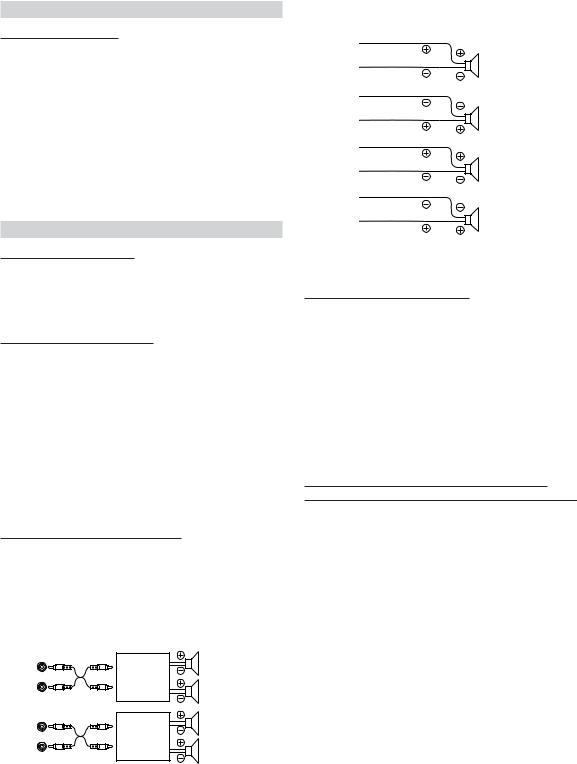
MP3/WMA
Playing MP3/WMA Data
PLAY CD-DA (Initial setting) / PLAY CD-DA & MP3
This product can playback CDs containing both CD and MP3/WMA data. However, in some situations (some enhanced CDs), playback may be difficult. For these special cases, you can select playback of CD data only. When a disc contains both CD or the MP3/WMA data, playback starts from the CD data portion of the disc.
CD-DA : Only CD data can be played back.
CD-DA & MP3 : Both CD data and MP3/WMA file tracks can be played back.
•Perform this setting before inserting a disc. If a disc has already been inserted, perform the setting after you remove the disc. (If you use an MP3 changer, you have to change discs.)
External Device
Turning Mute Mode On/Off
MUTE ON (Initial setting) / MUTE OFF
If a device having the interrupt feature is connected, audio will be automatically muted whenever the interrupt signal is received from the device.
Setting the AUX Mode (V-Link)
AUX IN ON / AUX IN OFF (Initial setting)
You can input TV/video sound by connecting an optional Ai-NET/ RCA Interface cable (KCA-121B) or Versatile Link Terminal (KCA410C) to this component.
You can change the AUX name display when AUX IN ON is set. Select the AUX name by pressing gor f. Then turn the Rotary encoder.
If the KCA-410C is connected, it is possible to select two AUX names.
•Via KCA-410C, up to 2 external devices with RCA output can be connected. In this case, press SOURCE/POWER to select AUX mode and then press BAND to select your desired device.
Connecting to an External Amplifier
P-IC ON (Initial setting) / P-IC OFF
When an external amplifier is connected, sound quality can be improved by stopping the power supply of the built-in amplifier.
P-IC OFF : Use this mode when the front and rear preamplifier of the unit are used to drive an external amplifier connected to the speakers. In this setting, the head unit’s internal amplifier has no output to drive speakers.
Front
left
Amplifier
Front
right
Rear
left
Amplifier
Rear right
P-IC ON : The speakers are driven by the built-in amplifier.
Speakers
SPEAKER
RIGHT FRONT Front right
SPEAKER
RIGHT REAR Rear right
SPEAKER
LEFT REAR Rear left
SPEAKER
LEFT FRONT Front left
•No sound is produced by the system when the power output is set to OFF.
Setting the External Digital Input
D-AUX ON / D-AUX OFF (Initial setting)
When an ALPINE Ai-NET compatible digital audio processor and a DVD player (DVE-5207) not compatible with Ai-NET are connected, set D-AUX to ON to enjoy 5.1-channel surround sound.
•After setting D-AUX to ON, make the setting in “Connecting an Optical Digital Compatible Audio Processor and an Ai-NET NonCompatible DVD Player.”
•Press SOURCE/POWER, and select the D-AUX mode, and adjust the volume, etc.
•Depending on the connected audio processor, DVD player sound may continue to be output, even though the source is changed to another one. If this occurs, set the DVD player's power to OFF.
Connecting an Optical Digital Compatible Audio
Processor and an Ai-NET Non-Compatible DVD Player
AP H510 / AP OTHER (Initial setting)
After setting D-AUX to ON in “Setting the External Digital Input,” do the following according to the audio processor type:
H510 : If a PXA-H510 and a DVD player (DVE-5207) not compatible with Ai-NET are connected (using an optical cable), use the H510 setting. Connect the DVD player to the optical digital input (DVD Player) terminal of the processor.
OTHER : If an audio processor other than a PXA-H510 and a DVD player (DVE-5207) not compatible with Ai-NET are connected (using an optical cable), use the OTHER setting. Connect the DVD player to the optical digital input (Head unit) terminal of the processor.
•After input selection is completed, turn the ignition off and back on again. Setting of the optical digital input switch is completed.
18-EN
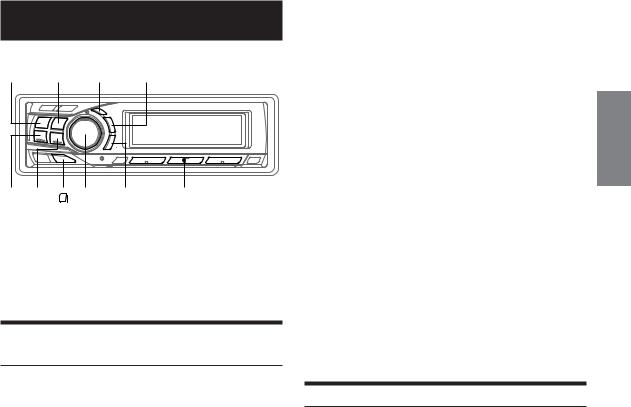
SAT Radio Receiver (Optional)
SOURCE/ |
|
POWER BAND TITLE |
8 |
g f |
Rotary |
9 |
Preset buttons |
|
encoder |
|
(1 through 6) |
SAT Receiver: XM or SIRIUS Receiver
When an optional XM or SIRIUS Receiver Box is connected via the Ai-NET bus, the following operations may be performed. However, the XM Receiver and SIRIUS Receiver cannot be connected at the same time.
Receiving Channels with the SAT Radio Receiver (Optional)
About SAT Radio
Satellite Radio* is the next generation of audio entertainment, with over 100 digital audio channels. For a small monthly fee, subscribers can hear crystal-clear music, sports, news and talk, coast-to-coast via satellite. For more information, visit XM’s website at www.xmradio.com., or SIRIUS' website at www.sirius.com.
To receive SAT Radio, the separately sold XM Direct™ or SIRIUS Satellite Radio Tuner and an appropriate Ai-NET Interface Adapter will be required. For details, consult you nearest ALPINE dealer.
*XM and its corresponding logos are trademarks of XM Satellite Radio Inc.
*Sirius and its corresponding logos are trademarks of Sirius Satellite Radio Inc.
•The SAT Receiver controls on the CDA-9851 are operative only when a SAT Receiver is connected.
1 Press SOURCE/POWER to select SAT Radio mode.
2 Press BAND to select between one of the three SAT Radio Preset Bands.
Each press changes the band:
XM mode:
XM1 → XM2 → XM3 → XM1
SIRIUS mode:
SR1 → SR2 → SR3 → SR1
3 Press 8 or 9 to select desired category.
4 Press gor fto select the desired channel.
Holding down gor fwill change channels continuously.
•When using the optional remote control (RUE-4190), an SAT Radio Channel can be directly called up with the numeric keypad of the remote control.
1While in XM or SIRIUS Radio mode, enter the Channel number you want to call up with the numeric keypad on the remote control.
2Press ENTER on the remote control within 5 seconds to receive the Channel.
If the channel number is 3 digits, the Channel is automatically received after the channel number is input.
Checking the SAT Radio ID Number
A unique Radio ID number is required to subscribe to SAT Radio programming. Each third party XM or SIRIUS radio comes with this number.
This number is an 8 character (for XM Radio) or 12 character (for SIRIUS Radio) alphanumeric number. It is printed on a label found on the SAT Receiver.
It can also be displayed on the screen of the CDA-9851 in the following way.
1 While receiving band, press gor fto select channel “0.”
The unit alternately displays “RADIO ID” for 2 seconds, then the ID number for 10 seconds.
While displaying “RADIO ID” as shown above, Demonstration (page 17) become nonfunctional.
2 To cancel the ID number display, set the channel to other than “0.”
•You cannot use “O,” “S,”“ I,” or “F” for the ID Number (XM radio Receiver only).
•You can check the ID number printed on a label on your third party, SAT Radio Receiver package.
19-EN

Storing Channel Presets
1 Press BAND to select the desired band you want to store.
2 After tuning in the desired channel, press and hold, for at least 2 seconds, any one of the preset buttons (1 through 6) into which you wish to store the channel.
The selected station is stored.
3 Repeat the procedure to store up to 5 other channels onto the same band.
•To use this procedure for other bands, simply select the band desired and repeat the procedure.
•A total of 18 channels can be stored in the preset memory (6 channels for each band; XM1, XM2 and XM3 or SR1, SR2 and SR3).
•If you store a channel in a preset memory which already has a station, the current channel will be cleared and replaced with the new one.
Receiving Stored Channels
1 Press BAND to select the desired band.
2 Press the channel preset button that has your desired satellite channel in memory.
Channel/Category Search Function
You can search for programs by Channel No. or Category.
1 Press in the XM or SIRIUS mode to select Channel Search mode or Category Search mode.
in the XM or SIRIUS mode to select Channel Search mode or Category Search mode.
Channel Search mode:
2 Turn the Rotary encoder to select the desired Channel No.* within 10 seconds.
* The Channel No. is selected within the selected Category.
3 Press Rotary encoder to receive the selected Channel No.
• Search mode is canceled by pressing and holding for at least 2 seconds in Channel Search mode.
•While in Channel Search mode, press 8 or 9 to select another Category.
• While in Channel Search mode, press to switch to the Category Search mode.
Category Search mode:
2 Turn the Rotary encoder to select the desired Category within 10 seconds.
3 Press Rotary encoder to receive the selected Category.
• |
Search mode is canceled by pressing and holding for at least 2 |
|
seconds in Category Search mode. |
• |
While in Category Search mode, press to switch to Channel |
|
Search mode. |
Quick Search Function
You can search for all Channels.
1 Press and hold for at least 2 seconds in XM or SIRIUS mode to activate Quick Search mode.
for at least 2 seconds in XM or SIRIUS mode to activate Quick Search mode.
2 Turn the Rotary encoder to select the desired Channel within 10 seconds.
The selected Channel is received.
Changing the Display
Text information, such as the channel name, artist name/feature, and song/program title, is available with each XM or Sirius channel. The unit can display this text information as explained below.
In XM or SIRIUS mode, press TITLE.
Each time you press this button, the display changes as shown below.
Channel Number*1 → Channel Name → Song Title → Artist Name → Auxiliary Data Field*2 → Clock → Channel Number*1
*1 The Channel Name display automatically changes after 2 seconds. *2 XM mode only:
When ADF is turned OFF, this information is not displayed (see “Setting the Auxiliary Data Field Display” on page 21).
•When the “Scroll Setting” (page 17) is set to “SCR AUTO,” the display scrolls continuously.
When the Scroll Setting is set to “SCR MANUAL,” the display scrolls only once after any function is performed (PRESET, BAND, SEARCH, etc.).
Press and hold TITLE for more than 2 seconds to scroll the display manually.
•“Channel Number” and “Clock” displays do not scroll.
•Depending on the model, the display may differ from the one shown above.
20-EN

Setting the Auxiliary Data Field Display
The XM Auxiliary Data Field (ADF) display can be switched on or off. There is no ADF function for the SIRIUS receiver.
1 Press MENU to select the SETUP mode.
2 Select “XMADF” by pressing gor f.
3 Select ON/OFF by turning the Rotary encoder.
When setting to ON, Auxiliary Data Field is displayed by pressing TITLE. (Refer to the “Changing the Display” section page 20.)
4 Press MENU to select RETURN.
The unit returns to normal mode.
Pressing and holding MENU for at least 2 seconds will return to normal mode.
21-EN
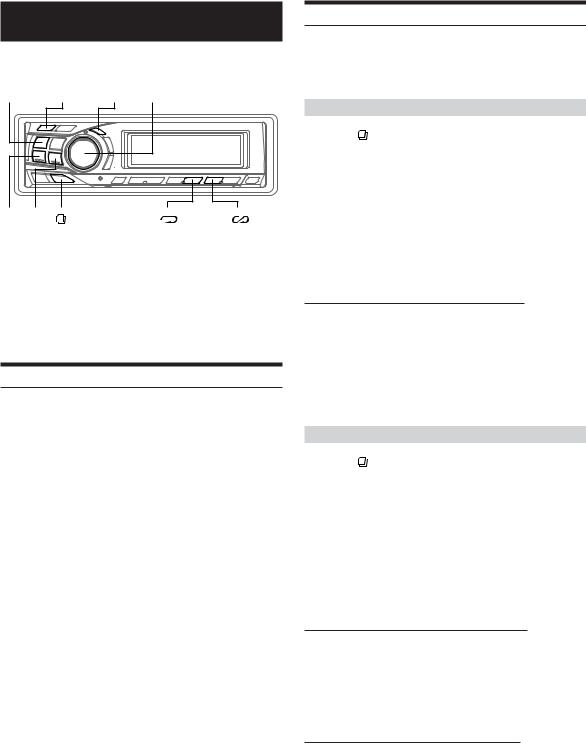
iPod™ Operation (Optional)
SOURCE/ |
|
POWER -/J |
TITLE Rotary encoder |
g f |
4( ) 5( ) |
An iPod™ or iPod™ Mini can be controlled from the CDA-9851, when connected to an optional Alpine Interface Adapter for iPod™ (KCA-420i). While connected to the CDA-9851, operation from the iPod™ is no longer possible.
•For details, refer to the Owner’s Manual of the connected Interface adapter for iPod™ (KCA-420i).
•For each function, refer to the iPod’s documentation.
Playback
1 Press SOURCE/POWER to switch to the iPod mode.
2 Press gor fto select the desired song.
Return to the beginning of the current song:
Press g.
Fast backward:
Press and hold g.
Advance to the beginning of the next song:
Press f.
Fast forward:
Press and hold f.
3 To pause playback, press -/J.
Pressing -/J again will resume playback.
•If a song is playing on the iPod when it is connected to the adapter, it will continue playing after the connection.
•If using the iPod with a changer, the Versatile Link Terminal (KCA410C) must be used. In this case, press BAND to select the changer mode applicable to the iPod.
Searching for a desired Song
An iPod can contain hundreds of songs. By keeping these songs organized in playlists, the CDA-9851 can use these to ease song searches.
•Press and hold for at least 2 seconds in the search mode to cancel the search mode.
for at least 2 seconds in the search mode to cancel the search mode.
Searching by Playlist
1 Press to select the PLAYLIST search mode.
Each press changes the search mode. 4 seconds after selecting PLAYLIST, the search mode will be automatically changed to the PLAYLIST search mode.
PLAYLIST → ARTIST → ALBUM → PLAYLIST
2*1Turn the Rotary encoder within 10 seconds, and select a playlist.
3 Press the Rotary encoder to play back a selected playlist.
To search for a song in the selected playlist
1After selecting the playlist in step 2*1, press to change to the song search mode of the selected playlist.
to change to the song search mode of the selected playlist.
2Turn the Rotary encoder within 10 seconds to select a song and press the Rotary encoder.
The selected song is played back.
•If you choose “iPod name” of iPod in step 2*1, all songs in iPod are played back.
Searching by artist name
1 Press to select the ARTIST search mode.
Each press changes the search mode. 4 seconds after selecting ARTIST, the search mode will be automatically changed to the ARTIST search mode.
PLAYLIST → ARTIST → ALBUM → PLAYLIST
2*2Turn the Rotary encoder within 10 seconds, and select an artist.
3 Press the Rotary encoder to play back all songs of the selected artist.
To search for an album of the selected artist
1After selecting the artist in step 2*2, press to change to the album search mode of the selected artist.
to change to the album search mode of the selected artist.
2*3 Turn the Rotary encoder within 10 seconds to select an album.
3Press the Rotary encoder to play back all songs of the selected album.
To search for a song of the selected album
1After selecting the album in step 2*3, press to change to the song search mode of the selected album.
to change to the song search mode of the selected album.
2Turn the Rotary encoder within 10 seconds to select a song and press the Rotary encoder.
The selected song is played back.
•If you choose ALL in step 2*2, all songs in iPod are played back.
•If you choose ALL in step 2*3, all songs of the selected artist are played back.
22-EN
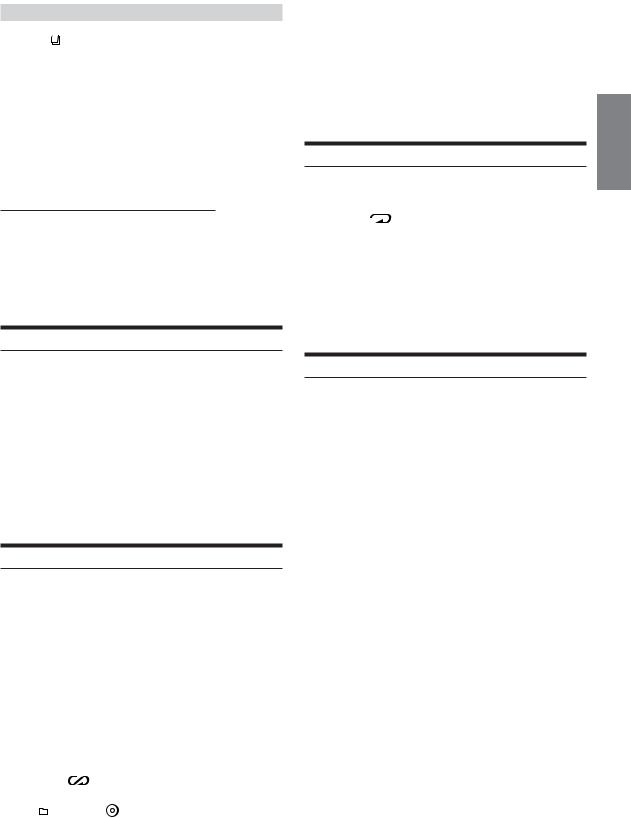
Searching by album name
1 Press to select the ALBUM search mode.
Each press changes the search mode. 4 seconds after selecting ALBUM, the search mode will be automatically changed to the ALBUM search mode.
PLAYLIST → ARTIST → ALBUM → PLAYLIST
2* Turn the Rotary encoder within 10 seconds, and select an album.
3 Press the Rotary encoder to play back all songs of the selected album.
To search for a song of the selected album
1After selecting the album in step 2*, press to change to the song search mode of the selected album.
to change to the song search mode of the selected album.
2Turn the Rotary encoder within 10 seconds to select a song and press the Rotary encoder.
The selected song is played back.
•If you choose ALL in step 2*, all songs in iPod are played back.
Quick Search
You can search for songs.
1 Press and hold for at least 2 seconds to activate Quick Search mode.
for at least 2 seconds to activate Quick Search mode.
2 Turn the Rotary encoder within 10 seconds to select a desired song.
The selected song is played back immediately.
•Press and hold for at least 2 seconds in the search mode to cancel the search mode.
for at least 2 seconds in the search mode to cancel the search mode.
•The Quick search in the iPod mode takes more time than the normal Quick search.
•“QUICK SEARCH” blinks in the display during Quick search.
Random Play Shuffle (M.I.X.)
The Shuffle function of the iPod is displayed as M.I.X. on the CDA9851.
Shuffle Albums:
Select an album randomly in the iPod, and plays back the songs of the album in sequential order. If a song has been selected in the playlist/ artist search mode before selecting Shuffle Album, only the albums within the playlist/artist are selected randomly. The songs of the album are played back sequentially.
Shuffle Songs:
All songs in the iPod are played back in random sequence. If a song has been selected in the playlist/artist search mode before selecting Shuffle song, only the songs of the playlist/artist/album are played back randomly.
1 Press 5 ( ).
The songs will be played back in random sequence.
|
|
|
|
|
→ M.I.X. → |
M.I.X. → (off) |
|
|
(Shuffle Albums) |
(Shuffle Songs) |
|
|
|
|
|
2 To cancel M.I.X. play, select (off) with the above procedure.
•For details of the search mode, refer to “Searching for a desired Song” (page 22).
•If a song is selected in the album search mode before selecting Shuffle (M.I.X.), the songs will not play back randomly even when Shuffle album is selected.
•If there is no album in the playlist, Shuffle (M.I.X.) will not function even when Shuffle album is selected.
Repeat Play
Only Repeat One is available for the iPod.
Repeat One: A single song is repeatedly played back.
1 Press 4 ( ).
The song will be played repeatedly.
RPT → (off) → RPT
(Repeat One) (Repeat One)
2 To cancel repeat play, select (off) with the above procedure.
•During repeat playback, no other songs are selectable by pressing gor f.
Displaying the Text
You can display the tag information of a song in the iPod.
Press TITLE.
Each press changes the display.
Artist Name → Album Name → Song Title → Elapsed Time → Clock → Artist Name
•“NO DATA” is displayed if there is no information.
•When the Scroll Setting (page 17) is set to “SCR MANUAL” press and hold TITLE for at least 2 seconds to scroll the tag information only once.
•Only alphanumeric characters (ASCII) can be displayed.
•If the artist, album or song name, created in iTunes, has too many characters, songs may not be played back when connected to the adapter. Therefore, a maximum of 250 characters is recommended. The maximum number of characters for the head unit is 64 (64 byte).
•Some characters may not be correctly displayed.
•“NO SUPPORT” is displayed when text information is not compatible with the CDA-9851.
23-EN
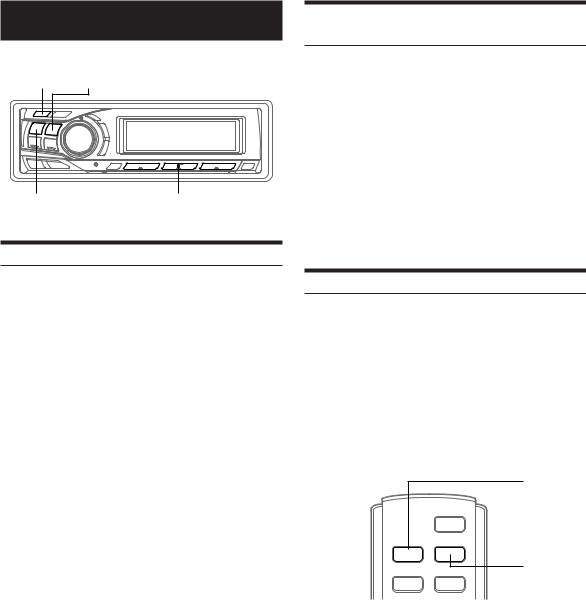
Changer (Optional)
-/J BAND
SOURCE/ |
Select buttons (1 through 6) |
POWER |
|
Controlling CD Changer (Optional)
An optional 6-disc or 12-disc CD Changer may be connected to this unit if it is Ai-NET compatible. With a CD Changer connected to the Ai-NET input of this unit, the CD Changer will be controllable from this unit.
Using the KCA-400C (Multi-Changer Switching device) or the KCA410C (Versatile Link Terminal) multiple changers can be controlled by this unit.
See “Multi-Changer Selection” on this page for selecting the CD Changers.
•The controls on this unit for CD Changer operation are operative only when a CD Changer is connected.
•The DVD changer (optional) is controllable from this unit as well as the CD changer.
1 Press SOURCE/POWER to activate the CHANGER mode.
The display shows the disc number and track number.
•The source indicator varies depending on the connected source.
•Press BAND to switch the Disc mode in the CD/Changer mode.
2 Press the disc select buttons (1 through 6) corresponding to one of the discs loaded in the CD Changer.
The selected disc number appears in the display and CD playback starts.
•After selecting the desired disc, you can operate in the same way as for the CD player of this unit.
For details, please see the CD/MP3/WMA section.
•If the “FUNC” indicator is illuminated, the disc select buttons become nonfunctional.
When a 12-disc CD Changer is connected:
To select discs numbered from 1 to 6, the procedure is the same as for the 6-disc CD Changer. To select discs numbered from 7 to 12, first press F. This changes the “D” indicator to “d.” Then press the desired preset button. With F activated, the preset buttons 1 to 6 will represent discs 7 to 12 respectively.
Playing MP3 Files with the CD Changer (Optional)
If you connect a changer compatible with MP3, you can play CDROMs, CD-Rs, and CD-RWs containing MP3 files on this unit.
1 Press SOURCE/POWER to switch to the MP3 Changer mode.
2 Press any one of the disc select buttons (1 through 6) corresponding to one of the discs loaded in the CD Changer.
3 To pause playback, press -/J.
Pressing -/J again will resume playback.
•The unit can play discs containing both audio data and MP3 data.
•For operating MP3 with an MP3 compatible CD Changer, refer to “CD/MP3/WMA” pages 9 to 13.
Multi-Changer Selection (Optional)
Alpine's Ai-NET system will support up to 6 CD Changers. When operating two or more changers, the KCA-400C (Multi-Changer Switching device) must be used. If you use 1 Switching device, you can connect up to 4 CD Changers. If you use 2 Switching devices, you can connect up to 6 CD Changers. When using KCA-410C (Versatile Link Terminal), you can connect two changers and two external outputs (AUX).
1 Press SOURCE/POWER on this unit to activate the CD Changer mode.
Alternatively, press SOURCE on the remote control (RUE4202) to activate the CD Changer mode.
SOURCE
BAND
2 Press BAND on this unit or the RUE-4202 to activate the CD Changer Selection mode.
The CD Changer Selection mode remains active for a few seconds.
3 Press BAND until the desired CD Changer indicator appears on the display.
Alternatively press BAND on the Remote Control until the desired changer indicator appears on the display.
•If the selected CD Changer is not connected, the display will show “NO CHGR“.
•To operate the selected changer, see “CD/MP3/WMA”(page 9).
•For further details about the external input (AUX) when using KCA-410C, see “Setting the AUX Mode (V-Link)” on page 18.
24-EN
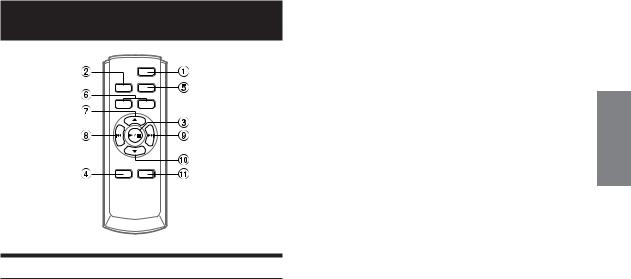
Remote Control
Controls on Remote Control
1Power Button
Press this button to turn the power on/off.
2Source Button
Press this button to select the audio source.
3-/J Button
Press this button to switch between the Play and Pause modes for CD.
4Audio Processor Button
Press the button to call the external audio processor mode when the external audio processor is connected.*1
*1 For the operation of external audio processor, refer to the Owner's Manual of the external audio processor you purchased.
5Band/Program Button
Radio mode: BAND Button
Press this button and the band will change. CD/Changer mode: To switch the disc mode.
6Volume Adjustment Buttons
To increase the volume level: Press the L button
To decrease the volume level: Press the K button
78 Button
Radio mode: Pressing this button will select, in ascending order, stations programmed into the radio's presets as shown below.
1 → 2 ... 6 → 1
CD Changer mode: DISC Select (UP) button
Press this button to select a disc in ascending order.
MP3/WMA mode: Folder Select (UP) button Press this button to select the folder.
8gDN Button
Radio mode: SEEK (DN) Button
CD mode: Press this button to go back to the beginning of the current track.
9fUP Button
Radio mode: SEEK (UP) button
CD mode: Press this button to advance to the beginning of the next track.
!9 Button
Radio mode: Pressing this button will select, in descending order, stations programmed into the radio's presets as shown below.
6 → 5 ... 1 → 6
CD Changer mode: DISC Select (DN) button
Press this button to select a disc in descending order. MP3/WMA mode: Folder Select (DN) button
Press this button to select the folder.
"Mute Button
Press this button to lower the volume by 20 dB instantly. Press this button again to cancel.
25-EN
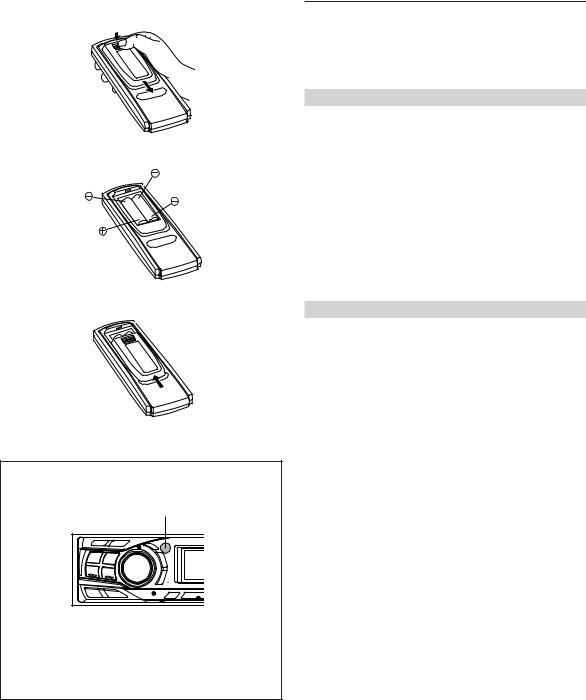
Battery Replacement |
|
Information |
|
|
|
Applicable battery: Use two “AAA” sized dry batteries or equivalent. |
|
|
|
|
|
1 Opening the battery cover |
|
|
|
In Case of Difficulty |
Slide out the battery cover while firmly pressing in the direction of the arrow.
2 Replacing the battery
Insert the batteries, observing the polarities as illustrated.
3 Closing the cover
If you encounter a problem, please turn the power off, then on again. If the unit is still not functioning normally, please review the items in the following checklist. This guide will help you isolate the problem if the unit is at fault. Otherwise, make sure the rest of your system is properly connected or consult your authorized Alpine dealer.
Basic
No function or display.
•Vehicle's ignition is off.
-If connected following instructions, the unit will not operate with the vehicle's ignition off.
•Improper power lead connections.
-Check power lead connections.
•Blown fuse.
-Check the fuse of the unit; replace with the proper value if necessary.
•Internal micro-computer malfunctioned due to interference noise etc.
-Press the RESET switch with a ballpoint pen or other pointed article.
Slide the cover as illustrated until a click is heard. |
Radio |
|
|
Unable to receive stations. |
|
|
• No antenna or open connection in cable. |
|
|
- Make sure the antenna is properly connected; |
|
|
replace the antenna or cable if necessary. |
|
|
Unable to tune stations in the seek mode. |
|
|
• You are in a weak signal area. |
|
|
- Make sure the tuner is in the DX mode. |
|
|
• If the area you are in is a primary signal area, the antenna may |
|
|
not be grounded and connected properly. |
|
|
- Check your antenna connections; make sure the antenna is |
|
Point the remote control transmitter at the remote control |
properly grounded at its mounting location. |
|
sensor. |
• The antenna may not be the proper length. |
|
Remote control sensor |
- Make sure the antenna is fully extended; if broken, replace |
|
the antenna with a new one. |
||
|
||
|
Broadcast is noisy. |
|
|
• The antenna is not the proper length. |
|
|
- Extend the antenna fully; replace it if it is broken. |
|
|
• The antenna is poorly grounded. |
|
|
- Make sure the antenna is grounded properly at its mounting |
|
|
location. |
Connectable to Steering Remote Control Interface Box
You can operate this unit from the vehicle’s control unit when an Alpine Steering Remote Control Interface Box (optional) (for sale in the near future) is connected. For details, contact your Alpine dealer.
26-EN
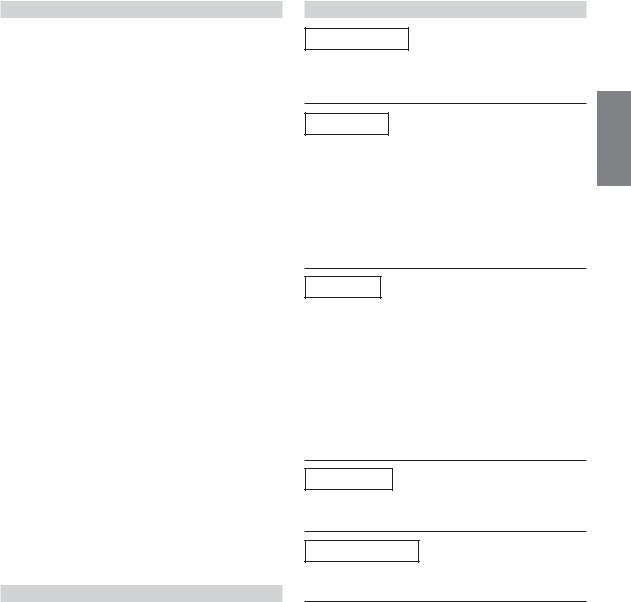
CD
CD Player/Changer not functioning.
•Out of operating temperature range +50˚C (+120˚F) for CD. - Allow the vehicle's interior (or trunk) temperature to cool.
CD playback sound is wavering.
•Moisture condensation in the CD Module.
-Allow enough time for the condensation to evaporate (about 1 hour).
CD insertion not possible.
•A CD is already in the CD player.
-Eject the CD and remove it.
•The CD is being improperly inserted.
-Make sure the CD is being inserted following instructions in the CD Player Operation section.
Unable to fast forward or backward the CD.
•The CD has been damaged.
-Eject the CD and discard it; using a damaged CD in your unit can cause damage to the mechanism.
CD playback sound skips due to vibration.
•Improper mounting of the unit.
-Securely re-mount the unit.
•The disc is very dirty.
-Clean the disc.
•The disc has scratches.
-Change the disc.
•The pick-up lens is dirty.
-Do not use a commercial available lens cleaner disc. Consult your nearest ALPINE dealer.
CD playback sound skips without vibration.
•The disc is dirty or scratched.
- Clean the disc; damaged disc should be replaced.
Error displays (built-in CD player only)
•Mechanical error
-Press c. After the error indication disappears, insert the disc again. If the above-mentioned solution does not solve the problem, consult your nearest ALPINE dealer.
CD-R/CD-RW playback not possible
•Close session (finalization) has not been performed. - Perform finalization and attempt playback again.
MP3/WMA
MP3 or WMA is not played back.
•Writing error occurred. The CD format is not compatible.
-Make sure the CD has been written in a supported format. Refer to “About MP3/WMA” (page 12-13), then rewrite in the format supported by this device.
Indication for CD Player
HIGH-TEMP
•Protective circuit is activated due to high temperature.
-The indicator will disappear when the temperature returns to within operation range.
NO DISC
•No CD is inserted.
-Insert a CD.
•Although a disc is inserted, “NO DISC” is displayed and the unit does not start to play or eject the disc.
-Remove the disc by following these steps:
1)Press the c button.
The movable display will open.
2)Press the c button again for at least 2 seconds while the movable display is open.
ERROR
•Mechanism error.
1)Press the c button and eject the CD.
If not ejecting, consult your Alpine dealer.
2)When the error indication remains after ejecting, press the c button again.
If the error indication still does not turn off after pressing the c button for a few times, consult your Alpine dealer.
•When “ERROR” is displayed:
If the disc cannot be ejected by pressing c, press the RESET switch (refer to page 6) and press c again.
If the disc still cannot be ejected, consult your Alpine dealer.
PROTECT
•A copy-protected WMA file was played back.
- You can only play back non-copy-protected files.
UNSUPPORT
•The disc is not written in a MP3/WMA supported format. - Use a disc written at the MP3/WMA supported format.
27-EN

Indication for CD Changer
HIGH-TEMP
•Protective circuit is activated due to high temperature.
-The indicator will disappear when the temperature returns to within operation range.
ERROR - 01
•Malfunction in the CD Changer.
-Consult your Alpine dealer. Press the magazine eject button and pull out the magazine.
Check the indication. Insert the magazine again.
If the magazine cannot be pulled out, consult your Alpine dealer.
•Magazine ejection not possible.
-Press the magazine eject button. If the magazine does not eject, consult your Alpine dealer.
ERROR - 02
•A disc is left inside the CD Changer.
-Press the eject button to activate the eject function. When the CD Changer finishes the eject function, insert an empty CD magazine into the CD Changer to receive the disc left inside the CD Changer.
NO MAGZINE
•No magazine is loaded into the CD Changer. - Insert a magazine.
NO DISC
•No indicated disc.
- Choose another disc.
Indication for SAT Receiver Mode
ANTENNA
•The XM or SIRIUS antenna is not connected to the XM or SIRIUS radio module.
-Check whether the XM or SIRIUS antenna cable is attached securely to the XM or SIRIUS radio module.
UPDATING (XM mode)
CALL 888-539- |
(SIRIUS mode) |
|
SIRIUS TO |
||
Scrolling display |
||
SUBSCRIBE |
||
|
||
|
|
•Radio is being updated with latest encryption code.
-Wait until encryption code is being updated. Channels 0 and 1 should function normally.
NO SIGNAL |
|
(XM mode) |
|
|
|
|
|
|
|
|
|
ACQUIRING |
|
(SIRIUS mode) |
|
SIGNAL |
|
Scrolling display |
|
|
|
|
|
•XM or SIRIUS signal is too weak at the current location.
- Wait until the car reaches a location with a stronger signal.
LOADING |
(XM mode) |
|
|
|
|
|
|
|
ACQUIRING |
|
(SIRIUS mode) |
SIGNAL |
|
Scrolling display |
|
|
|
•Radio is acquiring audio or program information. - Wait until the radio has received the information.
OFF AIR |
(XM mode) |
|
|
|
|
|
|
|
ACQUIRING |
|
(SIRIUS mode) |
SIGNAL |
|
Scrolling display |
|
|
|
•The channel currently selected has stopped broadcasting. - Select another channel.
– – – – – – – –
•The user has selected a channel number that does not exist or is not subscribed to.
- The unit will revert back to the previously selected channel.
•There is no artist name/feature, song/program title, or additional information associated with the channel at that time. - No action needed.
28-EN
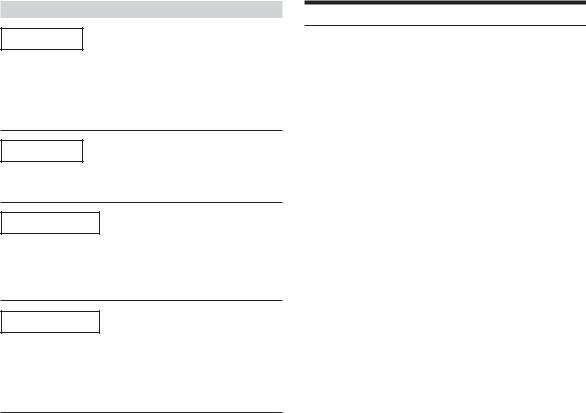
Indication for iPod Mode
NO IPOD
•The iPod is not connected.
-Make sure the iPod is correctly connected. Make sure the cable is not bent excessively.
•The iPod’s battery remains low.
-Refer to the iPod’s documentation and charge the battery.
NO FILE
•There are no songs in the iPod.
- Download songs to the iPod and connect to the CDA-9851.
ERROR - 01
•Communication error
-Turn the ignition key off, and then set to ACC or ON again.
-Check the display by reconnecting between the iPod and the adapter, using the iPod cable.
ERROR - 02
•Caused by the iPod Software Version not being compatible with the adapter KCA-420i (sold separately).
-Refer to the Owner's Manual of the adapter KCA-420i (sold separately) and update the iPod Software Version to be compatible with the adapter KCA-420i (sold separately).
Specifications
FM TUNER SECTION |
|
|
Tuning Range |
|
|
Area 1 |
87.7-107.9 MHz |
|
Area 2 |
87.5-108.0 MHz |
|
Mono Usable Sensitivity |
9.3 dBf (0.8 µV/75 ohms) |
|
|
||
50 dB Quieting Sensitivity |
13.5 dBf (1.3 µV/75 ohms) |
|
Alternate Channel Selectivity |
80 dB |
|
Signal-to-Noise Ratio |
65 dB |
|
Stereo Separation |
35 dB |
|
Capture Ratio |
2.0 dB |
|
AM TUNER SECTION |
|
|
Tuning Range |
|
|
Area 1 |
530-1,710 kHz |
|
Area 2 |
531-1,602 MHz |
|
Sensitivity (IEC Standard) |
22.5 µV/27 dB |
|
CD PLAYER SECTION |
|
|
Frequency Response |
5 – 20,000 Hz (±1 dB) |
|
Wow & Flutter (% WRMS) |
Below measurable limits |
|
Total Harmonic Distortion |
0.008% (at 1 kHz) |
|
Dynamic Range |
95 dB (at 1 kHz) |
|
Signal-to-Noise Ratio |
105 dB |
|
Channel Separation |
85 dB (at 1 kHz) |
|
PICKUP |
|
|
Wave length |
795 nm |
|
Laser power |
CLASS I |
|
REMOTE CONTROL |
|
|
Battery Type |
AAA batteries (2 pcs.) |
|
Width |
42 mm (1-21/32") |
|
Height |
121 mm (4-25/32") |
|
Depth |
23 mm (29/32") |
|
Weight |
50 g (1.8 oz) |
|
GENERAL |
|
|
Power Requirement |
14.4 V DC |
|
|
(11–16 V allowable) |
|
Power Output |
18 W RMS × 4* |
|
*Primary amplifier ratings per CEA-2006 Standard
•Power output: measured at 4 Ohms and ≤ 1% THD+N
•S/N: 80 dBA (reference: 1 W into 4 Ohms)
Maximum Pre-Output Voltage |
2 V/10 k ohms |
Bass |
+20/-14 dB at 60 Hz |
Treble |
±14 dB at 10 kHz |
Weight |
1.6 kg (3 lbs. 8 oz) |
CHASSIS SIZE |
|
Width |
178 mm (7") |
Height |
50 mm (2") |
Depth |
160 mm (6") |
NOSEPIECE SIZE |
|
Width |
170 mm (6-11/16") |
Height |
46 mm (1-13/16") |
Depth |
19 mm (11/16") |
•Due to continuous product improvement, specifications and design are subject to change without notice.
29-EN
